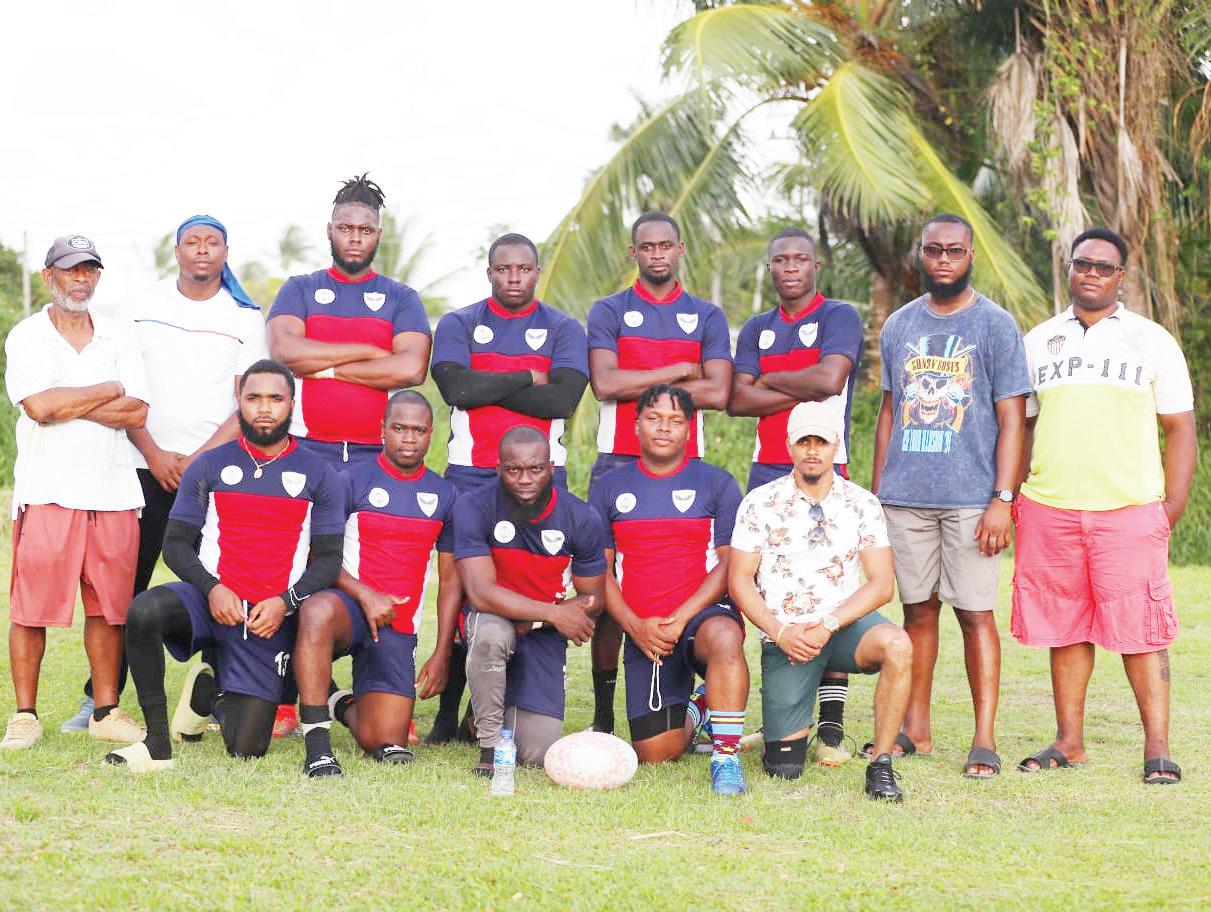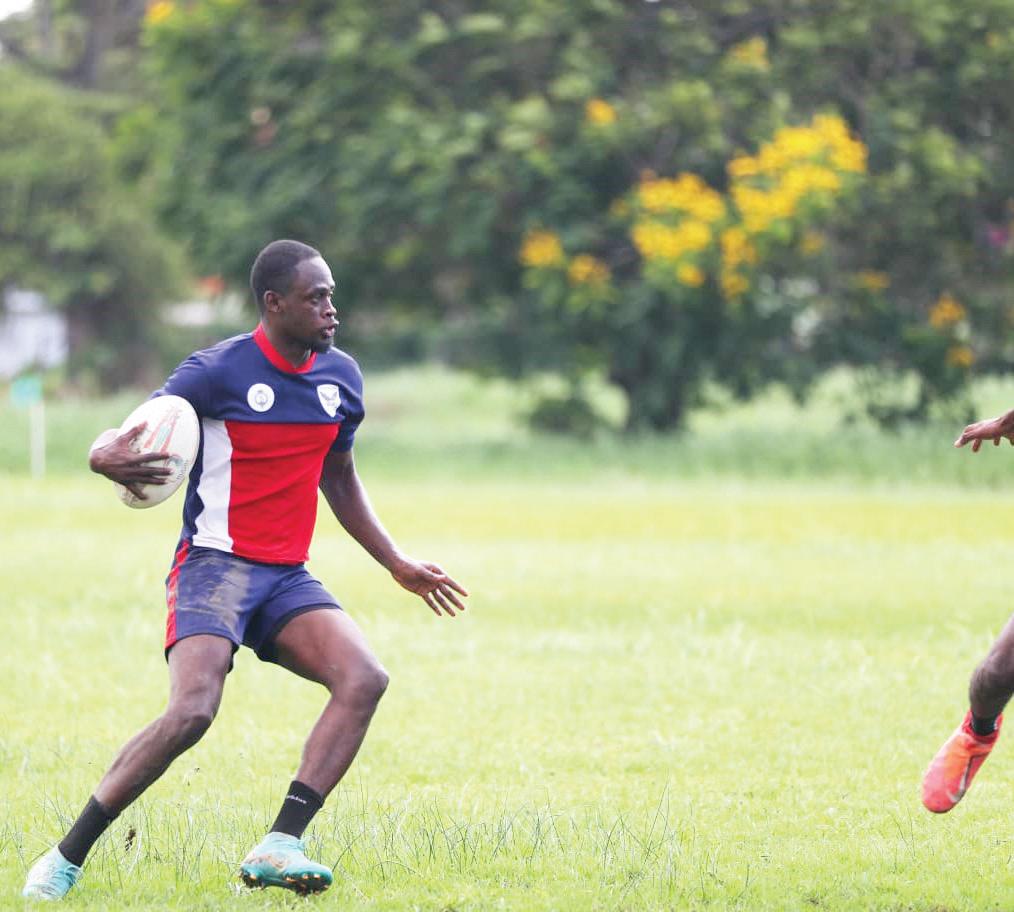



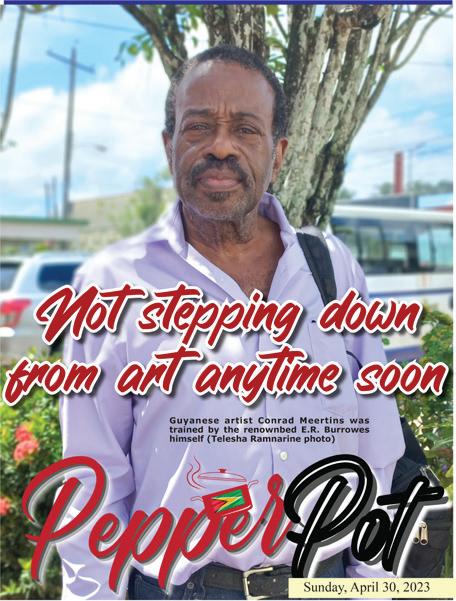





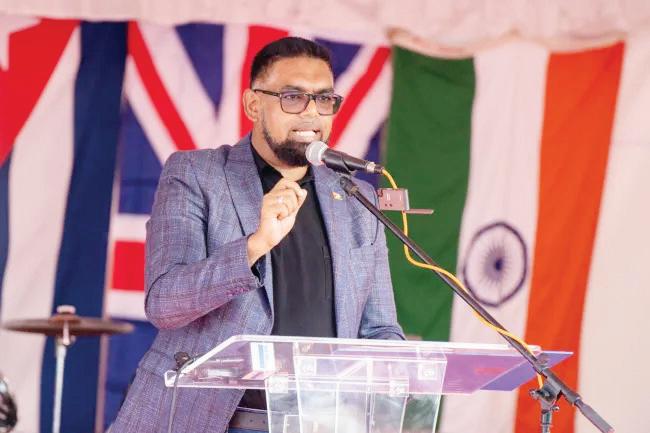
















NOTING that every community in Guyana is being transformed at an unimaginable pace, President Dr. Irfaan Ali on Saturday welcomed the commissioning of the state-of-the-art, 150-bed, US$5 million Sheriff General Hospital on the West Coast Demerara in Region Three (Essequibo Islands-West Demerara).



Located at Leonora, the hospital, which will comprise six operating theatres and a modern stem-cell research lab, will bring advanced healthcare closer to home for the thousands of res-
idents living in Region Three, as well as those in Region Two (Pomeroon-Supenaam).
The facility is part of over US$1 billion in investment currently taking place in Region Three, which is fast becoming a major economic hub. However, the president noted that the realisation of the hospital is indicative of the major investment currently taking place all across Guyana.

Dr. Ali related that across the country, Guyana is currently experiencing over $200 billion in public and private sector investment.
“This is not the story of Region Three and Le-
onora alone; this is the story of every single region in this country. Every community is being transformed at an unimaginable pace. The journey of development in Guyana is one that is continuously changing,” Dr. Ali said.
He added, “Our message is a singular message; not designed by geographic locations or circumstances, not designed by audience, by political opportunism, designed with interest of people at the centre of the message and plans. We will deliver prosperity to every home and every Guyanese.”
According to President Ali, the fast pace of advancement in Guyana
requires a new level of effort. As such, he thanked the private sector for being confident in the government to make major investments and contribute to the massive transformation of the country.
The country’s transformation is part of the government’s people-centred approach to delivering prosperity to every home and every Guyanese, the President reminded those gathered at the function.
“I stand humbled by the fact that this government is delivering better education, better healthcare, legislation, housing, infrastructure, a better
country for all the people of Guyana,” President Ali proudly declared.
The new hospital was built by the Sheriff Group of Companies headed by Mr. Shareef Ahmad.
“We have to accelerate to meet the demands of development coming to this region. As we advance; as we move forward, I commend the Ahmad family. For those in the diaspora, this is an example of putting action into words… when members of the Diaspora come back and invest and get actively involved in the transformation,” Dr. Ali said.

The hospital is the latest in a series of medical facilities being built by the Sheriff Group of Companies. The company is also expected to construct a Specialty Hospital at Palmyra, in Region Six (East Berbice-Corentyne), which is expected to provide up 400 jobs to Berbicians.
Additionally, preparatory works have also begun for a major facility at Houston, on the lower East Bank Demerara. The group already has a medical facility on Sheriff Street, in suburban Subryanville.
(BBC) - The former prime minister of Sudan has warned that the conflict in his country could become worse than those in Syria and Libya. Abdalla Hamdok said the fighting will be a "nightmare for the world" if it continues.
The Sudanese army says it is attacking the capital Khartoum from all directions, using heavy artillery. Almost two weeks of fight-
ing has left hundreds dead, while tens of thousands of people are fleeing the country.

Thursday night's extension of an uneasy ceasefire between the rival factions followed intensive diplomatic efforts by neighbouring countries, as well as the US, UK and UN. But the 72-hour extension has not held. Air, tank anSpeaking at a conference in the Kenyan capital, Nairobi, Mr Hamdok called for a unified international effort to persuade the Sudanese military leader and the head of a rival paramilitary force
to hold peace talks. "This is a huge country, very diverse ... I think it will be a nightmare for the world," he said. "This is not
a war between an army and small rebellion. It is almost like two armies - well trained and well-armed."


Mr Hamdok - who served as prime minister twice between 2019 and 2022 - added that the insecurity could become worse than the civil wars in Syria and Libya. Those wars have led to hundreds of thousands of deaths, created millions of refugees and caused instability in the wider regions. The fighting in Sudan broke out on 15 April as the result of a bitter power struggle between the regular army and the Rapid Support Forces (RSF).
Army commander Gen Abdel Fattah al-Burhan and RSF chief Gen Mohamed Hamdan Dagalo, better known as Hemedti, disagree about the country's proposed move to civilian rule, and in particular about the timeframe of the 100,000 strong RSF's inclusion into the army.
Both factions fear losing power in Sudan, partly because on both sides there are men who could end up at the International Criminal Court for war crimes committed in the Darfur region almost 20 years ago. Millions of people remain trapped in Khartoum, where there are shortages of food, water and fuel.
Sudan's army has urged people in Khartoum to re -
main indoors and stay away from windows, as it deploys tanks and other artillery in an effort to recapture areas held by the RSF.
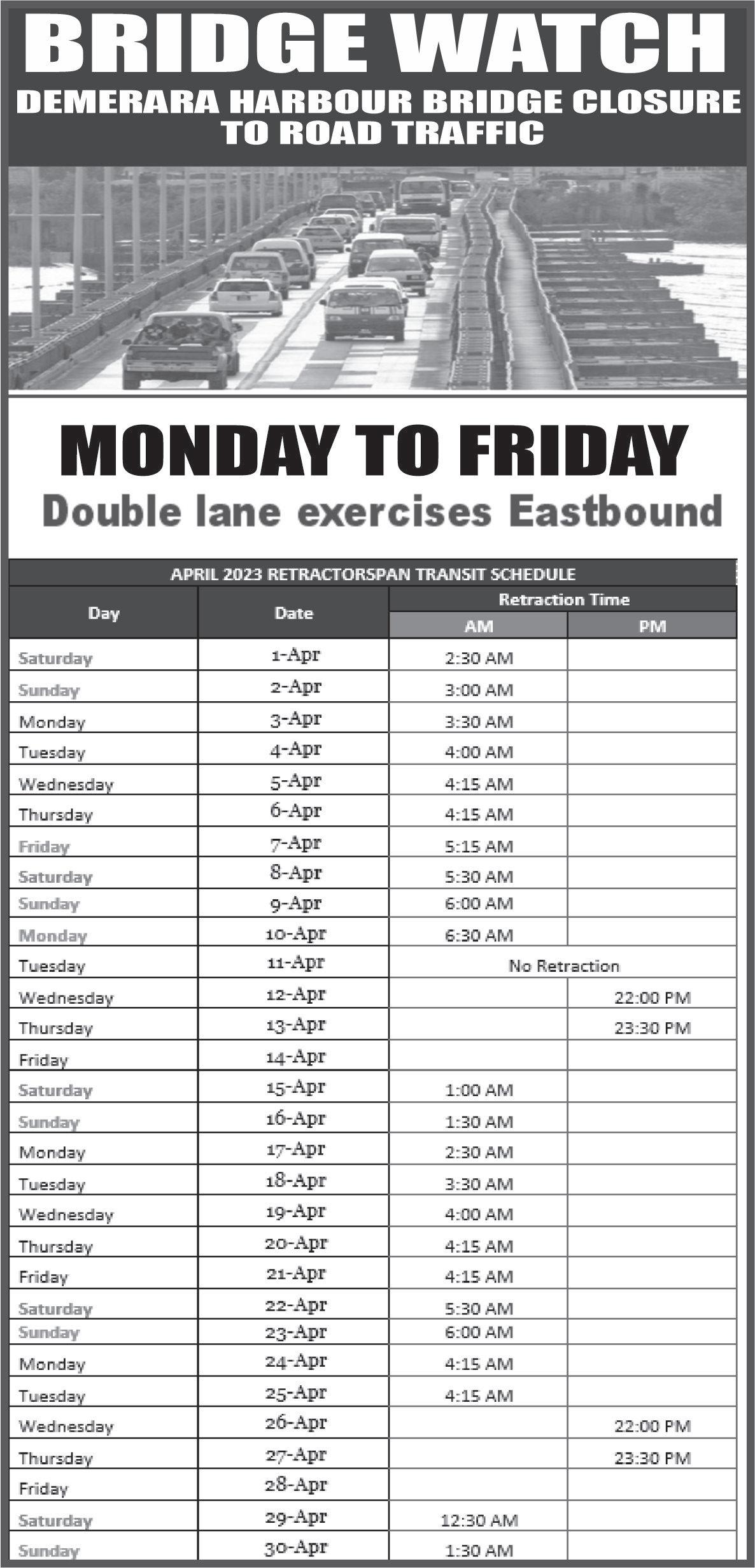

The RSF says the army is widening the conflict by deploying the Central Reserve police - a unit with a reputation for brutality against civilians.
Violence is also reported to have been particularly bad in El Geneina, a city in Darfur in western Sudan, with claims that militia groups have looted and torched markets. Hemedti has told the BBC he will not negotiate until fighting ends. He said his fighters were being "relentlessly" bombed since the truce was extended.
"We don't want to destroy Sudan," he said, blaming army chief Gen Abdel Fattah al-Burhan for the violence. The UK government said it was winding up its own evacuation efforts on Saturday evening. It has established a diplomatic presence in Port Sudan, with an office at the coastal city's Coral Hotel. Around 2,000 people have arrived in the Saudi coastal city of Jeddah after being evacuated from Port Sudan. Most are expected to be flown home via charter flights arranged by their governments within the next few days.
AFTER a protracted three-year presence, La Niña has left the global atmospheric scene, making way for a likely imminent transition to El Niño, a meteorological event that typically distributes weather patterns in the opposite way. That could be relief for some drought-afflicted areas such as the Horn of Africa, but may spell trouble for other parts of Africa, Central America and Far East Asia.
Given the record number of people facing acute food insecurity, the Food and Agriculture Organisation of the United Nations (FAO) is scrutinising the areas in the globe that are especially vulnerable to El Niño and how anticipatory action could be taken to mitigate its risks.
According to a new report by FAO’s Global Information and Early Warning Systems of the Markets and Trade Division and the Office of Climate Change, Biodiversity and Environment, Southern Africa, Central America and the Caribbean and parts of Asia are of particular concern, as a number of countries in these regions already face high levels of acute food insecurity and key cropping seasons fall under the typical El Niño weather patterns of drier conditions. Northern areas of South America are also at risk to potential dryness, while Australia normally experiences suppressed rainfall.
“Early warnings mean


that we have to take early and anticipatory action, and we will support our members in these efforts, to the full extent resources allow,” said Rein Paulsen, head of FAO’s Office for Emergencies and Resilience.
In the wake of the El Niño episode of 2015 and 2016, which affected more than 60 million people in around 23 countries, FAO has worked assiduously with its Members – including many of those where food security is likely to be impacted by the coming El Niño – and other UN agencies to establish anticipatory action plans and protocols.
Standard operating procedures have been crafted to expedite timely interventions such as setting up community seed stores, assessing strategic food reserves and bolstering animal health surveillance campaigns.

For example, FAO has developed Anticipatory Action protocols for drought in Burkina Faso, Chad, Niger, southern Madagascar, Malawi, Zimbabwe, the Philippines, Pakistan, and in Central America, and is ready to act early, in coordination with governments and partners, should the forecasts materialise.
Given the most recent forecasts that have raised the likelihood of an El Niño event occurring from June onwards, FAO is already setting in motion initial preparations to support af-
fected countries.

“Forecasts at this point are clear but inevitably can only be put forth with low confidence due to their low power during the May-June-July period,” explained Oscar Rojas, FAO Agrometeorologist.
El Niño events typically occurs every two to seven years, with La Niña episodes and neutral conditions filling the years in-between. Catalysed by a warming of Pacific Ocean waters, El Niño has a major influence on temperature and precipitation patterns over many parts of the world, driving extreme weather events including drought, flooding and storms.
While El Niño events and impacts are never alike, the broadly typical patterns enhance predictable regional consequences. FAO’s approach has been to map changes in vegetation conditions across the globe’s croplands and combine this analysis with crop calendars to better understand how rainfall deficits may affect production – the effects of water stress vary throughout a crop’s life cycle. This approach helps to identify areas at higher risk - those where dry conditions impact the entire crop cycle - and guide the type of interventions that should be implemented.

Under the Standard
Operating Procedures for Early Action to El Niño/La Niña Episodes by the UN Interagency Standing Committee (IASC), anticipatory action initiatives advance in step with the likelihood that an El Niño event is brewing. FAO, OCHA and the WMO together with other partners are monitoring the situation to determine the countries at highest risk later in the year.
Mapping the risks
While rain will be a welcome relief to farmers in Argentina and Near East Asia, El Niño can also cause severe flooding, which can harm agriculture and increase the risk of disease. That’s a particular risk FAO has examined in relation to East Africa, which
has faced four years of extreme rainfall deficits and where recovery will at any rate take a long time even if rainfall finally returns.
Australia, Brazil and South Africa, all major cereal producers and exporters, are among the countries at risk of dry conditions, as are a host of other countries in Central and West Africa, Southeast Asia and the Caribbean.
The inverse risk of excessive rainfall holds for exporters such as Argenti-
na, Turkey and the United States of America, as well as for countries in Central Asia.
El Niño typically raises the global average temperature and was associated with the record high registered in 2016, when various carbon-releasing calamities occurred, including forest and peatland fires in Indonesia and billions of trees decimated by drought in the Amazon. (FAO)
THE Commission of Inquiry (CoI) into the March 2020 General and Regional Elections set up by President Dr. Mohamed Irfaan Ali has completed its work. The report was handed over to the President by Commission Chairman, Justice (Retired) Stanley John and the findings are now in the public domain.
The report found that there was 'a conscious and deliberate-even brazen effort'- to violate the provisions of Section 84 (1) of the Representation of the People Act by senior officials of the Guyana Elections Commission (GECOM).
President Ali must be commended for setting up the Commission which was comprised of eminent jurists from Guyana and the Caribbean. Immediately upon taking political office, President Ali committed himself to setting up the Commission in order to lay bare what ac-
tually transpired during the tabulation and declaration of the results of the elections.
The Commission was chaired by Retired Justice of Appeal of Turks and Caicos Stanley John, and included former Chancellor of the Judiciary of Guyana Carl Singh and High Court Judge (Belize) and former Justice of Appeal (ag) in the Eastern Caribbean Supreme Court Goedfrey Smith.
The report implicated several key operatives of the GECOM Secretariat including its then Chief Elections Officer, Keith Lowenfield; Deputy Chief Elections Officer, Roxanne Myers and Returning Officer of Region Four, Clairmont Mingo for their role in attempting to subvert the will of the electorate in favour of the APNU +AFC coalition.
According to the findings, the identified GECOM officials “abandoned all need for neutrality and impar -
tiality and demonstrated a bias for a competing political party and in the course of events over those days, showed an open connection with that party and by their efforts, sought a desired result for that party.


“The CEO, by his overall conduct, opened himself to the criticism that the spreadsheet was introduced for ulterior motives and not for efficiency. Indeed, the use of the spreadsheet created turmoil, caused major disruptions and slowed the tabulation process. The CEO knew, or ought to have known that the methodology approved by GECOM for the entertainment and tabulation of votes was through the use of SOPs.”
There is no need to go into all the details and ramifications of the report except to make the point that the findings pointed to a need to put in place the necessary safeguards to prevent
a recurrence, especially in view of the impending local government elections due on June 12.
The Guyana Elections Commission has already commenced the process of putting in place the necessary mechanisms to ensuring that the local government elections are conducted in a free, fair and transparent manner.
Work has also commenced at the legislative level to increase the penalties for GECOM officials found guilty of any action or actions aimed at manipulating the results of the elections. These are all positive developments. Unfortunately, the PNC seems hesitant to lend its support to these initiatives and continue instead to fish for 'red-herrings' with a view to cast doubts on the integrity of the electoral process.
In the final analysis, it is the electorate that will
determine the outcome of the elections and it is the responsibility of GECOM to ensure that every vote is counted and that the elections are held in a free, fair and transparent manner.
In a sense, the report can be seen as a re-confirmation of what had already been known by the Guyanese people and the international community, namely that the PPP/C had won the elections by a comfortable majority of votes based on the Statements of Polls (SOPs) submitted by GECOM immediately after the close of poll.
What resulted thereafter were blatant attempts by some 'rogue' elements within the GECOM Secretariat in collaboration with APNU+AFC operatives to manipulate the results of the elections in order to secure a 'victory' for that coalition.
The report has now, hopefully, put to rest any lingering fear or concern
individuals may have had regarding the final declaration of the results of the March 2020 General and Regional elections and hopefully debunk the false and misleading narrative of the APNU+AFC coalition that it was 'cheated' out of political office.
Elections, both national, regional and local are serious business. It represented a mandate from the electorate as to whom and from which party or organisation their elected representatives should come from and any attempt to subvert that mandate must be dealt with by the full force of the law.
Such actions as happened during the March 2020 elections have no place in a modern and civilised society and must be condemned by all those who cherish the ideals of a society based on democracy and the rule of law.
Dear Editor,

Our country will soon have Local Government Elections, the first elections to be hosted by the Guyana Elections Commission (GECOM) since the debacle following the March 2020 polling processes. It is time to re-look at some of the core influencing factors to the problems that threatened the core fabric of democratic existence and took the country to the precipice of national incivility.
No loopholes should prevent the imposition of the strongest penalties on those culpable for the flagrant violations of the applicable laws, because of the need to make
the eradication of elections
rigging absolute and to assure national confidence and credible election results.
As a collective, our citizens are aware of the massive degree of caution undertaken by the newly appointed administrators, to lift the suffered credibility of the organisation caused by the questionable actions of the former Chief Elections Officer (CEO), Keith Lowenfield et.al cabal. One, therefore, anticipates the delivery of a more fluent results-driven agenda that will be instructive to commencing a necessary resuscitation of national confidence required for an enhanced GECOM’s image. Historically, there is much justification for condemna-
tion of the role officials of the GECOM played and were able to escape with as they flagrantly abused the related laws and approved procedures. Frankly speaking, for decades, the key orchestrators were protected and rewarded for cheating the nation by the PNC who through clandestine maneuvers supported the muscled manipulation of decision-making and controls of the Elections Commission.
History has documented the distasteful experiences of the PPP who were kept in opposition due to the damning condemnatory controls of GECOM Commissioners like Harold Bollers. Comparatively, one only has to take a cursory look at the decisions of President Granger’s imposed
The attempts targeted a repeat at re-establishing undemocratic foundational fault lines that had supported the PNC’s thievery for decades. Thankfully, the abuses of this power were wrenched away by the decisions of the Caribbean Court of Justice (CCJ) when the challenges were addressed.
Although he previously operated from within the shadows and under the covers of the political imbalance at the Commission Level, the infamous CCJ’s decision concerning James Patterson as Chairman served to strip Lowenfield of his disguising cover as he had to step up in the most flagrant ways. The
likely results that he would have been caught naturally materialised, but barely, as his ejection would not have materialised without the interventionist guardian rejection of the national and international communities.
Rational observation of the scenario points to the systemic cheating agenda and their seeming immunity to rigging. These influences stem from the core character of the PNC operatives, which informs the harder problem to dispel for long-term focus and address. What is certain is that deliberate attempts to distort the outcome of the elections by the senior functionary within GECOM, must not be condoned.
Consequently, Lowen -
field, Myers, and Mingo must face the courts immediately and stand the consequences for their alleged deliberate and blatant attempts to derail the National and Regional Elections in 2020. The swift execution of justice in this respect is required to unequivocally confirm that it is not at all ok to cheat and steal in particular, the rights and destiny of our peoples.
Editor, since 1968, the PNC operatives took pride in rolling out an indoctrination agenda that achieving and maintaining power by any means necessary, is a nationalistic ideal. Sadly, and duplicitously, those who were more strongly involved in
Continued on page 7

Five weeks ago, prominent and wealthy city businessman Mr. Nazar Mohamed has for the first time in his life, entered the political arena on the People’s Progressive Party Civics’ (PPP/C) ticket as a councillor for the Eccles/Ramsburg Neighbourhood Council in the June 12 Local Government Elections (LGE).
But when asked if he would enter national politics, he quickly ruled it out and stated that he is semi-retired. However, as Chairman of the Republic Park community development group, Mohamed developed a keen interest in local politics and in
the development of his neighborhood and became a strong community activist on issues affecting the people. Known to many as ‘Shell’ Mohamed, the successful businessman who lived in the community for more than four decades, is well-known and highly respected and appreciated by the people and his business colleagues.
Shell Mohamed, who came from humble beginnings, was born in the tiny village of Johanna Cecelia on the Essequibo Coast seven decades ago. And although his father was a sawmill worker, poverty was the way of life for the Mohameds who lived in a two-bedroom house with no running water, electric-
ity, a leaking roof, and a latrine located at the back of the house. Despite being poor, Mr. Mohamed said what had mattered most was love and happiness, which was abundant in the home.
The young Mohamed was an avid sports fan who liked the outdoors: hunting, fishing, and swimming. His favorite sport was cricket and as revealed by his childhood friends, he was an impressive batsman. Even though his boyhood days were full of fun and excitement, Mohamed had showed a keen interest in Islam and like his parents, he attended Madrasa, where he read the Holy Quran, and followed the teachings of the late Proph-
et and Messenger of God–Muhammad. Today, he is a devoted Muslim.

Shell Mohamed loved to read, and education was and still is the foundation of his life. After primary school where he excelled in Mathematics and was a brilliant student, he attended the Anna Regina Secondary School, but was forced to drop out because his parents could not afford the bus fare to send him to school. However, he did not give up on education. He educated himself through various means; but shortly after his father, who was his hero died, Mohamed being the eldest child, was forced to work to maintain a family of nine.
If anyone knew what they wanted in life and how to achieve it, it was Nazar Mohamed. At a young age, he knew that working for someone else was not his calling, so he ventured into business and became his own boss as a trader.
He struggled for a while, but as his business flourished, he established several other companies, which ultimately shaped his future. And even though he is currently the managing director of an empire - Mohamed’s Enterprise - comprised of five companies, he remains the humble son of a sawmill worker and a family man.
As the country’s leading philanthropist, Nazar Mohamed has given gen-
erously to many charitable groups, the poor and the disabled and assisted several persons to become lawyers, doctors, and other professionals in Guyana and abroad.
Well-liked by the residents of his community, we believe that Mr. Nazar Mohamed’s election as a councillor of the Eccles/ Ramsburg district is assured. He is intelligent, honest, trustworthy, and dedicated, and a remarkable person who would not tolerate any type of corrupt practices. His primary goal is to provide outstanding service to the people of the community.
Sincerely, Dr. Asquith Rose
rigging elections in Guyana were naturally idolised in the PNC’s ranks. In this context, the full control of GECOM was not enough to support their rigging platform, but a mandatory component of their wider focused manipulation areas for strategic manipulation.
In 1973, the PNC used the Army to blatantly rig the National Elections and they murdered and killed in the process. We must never forget the ballot box martyrs who paid with their lives for standing up against the PNC-directed murderous assaults. The 1980 and 1985 elections were massively rigged and it was this massive rigging that caused the people of this country to unite in the formation of the Political Committee for Democracy, (PCD); eventually leading to the dawn of a new era in 1992 when the PPP/C won the National and Regional Elections.
Again, the APNU+AFC attempts to steal the Government in 2020, forced the united opposition to strongly resist, and with the unflinching support of the international community a newly formed ‘Guardian of democracy,’ emerged from the Guyanese electorate.
They resisted for five long months, eventually winning their truthful people elected democratic rights to govern this country. During the process, it became clear that Lowenfield had deliberately engineered and allowed the usage of the illegal spreadsheets of fictitious results.
Further, the more diligent our guardians were, the more he demonstrated his ulterior motives and denied the usage of the legal Statements of Polls for the tabulation process. As the CEO of the GECOM Secretariat, his conduct dealt a deep body blow to the integrity of Guyana’s electoral system and cherished democratic values. Such occurrences justly and forcefully must be condemned as the ultimate betrayal of trust in the highest election official in the land, by the people of Guyana.
As for Myers, her attitude and role in the efforts to derail the process were most distasteful and typically what is not required in a DCEO of GECOM. She insulted the imminent foreign observers and was certainly a stranger to the truth. Myers' remarks to the party agents and international observers were condescending, insulting and distasteful as she at -
From page 6
tempted to force them out of the tabulation room with the assertion “take your rubbish with you and leave.”
The PNC used Lowenfield to catapult Mingo from Region #5 to Region #4 as Returning Officer (RO), which was a clear indication of their intentions. Mingo's role in the use of the Lowenfield spreadsheet was indeed vehemently opposed. Several persons are continuing to work at GECOM who were summoned to appear before the Commission of Inquiry but did not appear. It must be noted that GECOM will still have to further cleanse itself from the remnant rogue elements and ensure adequate internal counter-checking mechanisms.
The Commission of Inquiry must be complimented for a good job. However, those who are before the court must be given a speedy trial, and when found guilty they must be prosecuted so as to send a clear message on rigged elections’. Our citizens now demand a no-tolerance with the Lowenfield, Myers and Mingo type of operations!
Yours truly, Neil Kumar
THIS week, the public was told by General Secretary of the ruling People’s Progressive Party Civic (PPP/C), Dr Bharrat Jagdeo that he is aware that the A Partnership for National Unity (APNU) and its supporters in the People’s National Congress Reform (PNC/R) are engaged in acts of intimidation and
threats of violence against those Afro-Guyanese who have either supported the PPP/C as candidates or backers for the June 12 local government polls.
He said that he was not having it and would more than likely call on the Guyana Police Force to investigate these reports of intimidation. Jagdeo made it clear
too that any person or victim of fraud or unscrupulous acts should report their case to the Police now regardless of who is the alleged perpetrator.
Jagdeo was convinced that APNU does not “own” Afro-Guyanese and was not really concerned about their well-being and progress in Georgetown, Berbice, Bartica and Linden, to name a
few areas. He said that Afro-Guyanese have the right to decide what is best for themselves as guaranteed by the Constitution and the UN Charter among other doctrines and laws.
Jagdeo is definitely correct, and right to say that Afro-Guyanese are entitled to choose whom they associate with and their political party of choice.
If these persons choose the PPP/C over the APNU to support as either candidates or backers, then they should not be the target of any political campaign or be made to feel victimised.
It is foolish to comprehend how stupid and backward one has to be, to tell them they are being used, and cannot choose which political party they feel has their best interest at heart, in 2023. Also, the opposition and their henchmen who are doing this act, must be prosecuted and the long arm of the law applied where necessary.
If the APNU wants remorse or empathy for their loss of support, they will not find any sympathy from the public, especially Afro-Guyanese who have grown tired of the internal fight, incompetence, mismanagement, internal politics, rancour and political stench coming from Congress Place. They are tired of the talk and dialogue about race and discrimination, and the alleged looming apartheid.
Afro-Guyanese want a leader who thinks with his brains and sees issues for what they are, and not through the lenses of race. They know that if they stay, like lambs, the next eventuality in the realm of opposition politics is that they will be slaughtered or a game of collateral damage will take place.

So, the public would see justification in the move of Patricia Chase-Green, Malcolm Ferreira, Trichria Richards and many others who crossed over to the PPP because PNC/APNU’s record does not inspire confidence or impress them.
As a matter of fact, the APNU+AFC track record was one of poor contract execution, endless contractual problems and project flaws in Georgetown, Linden and Bartica to name a few. The drains, streets and communities in Afro-Guyanese areas are in a state of morbid
decline with no emphasis on wholesome infrastructure and development after the APNU+AFC had access to the public purse from 2015 to 2020.
And, only a fool could not see why the PPP/C, with all its baggage, could now attract support from Afro-Guyanese in this modern age.
The bottom line is the APNU+AFC Administration did nothing for Afro-Guyanese while in office, except give lands, houses, fat salaries and perks to a small few of their supporters. They were allegedly discriminatory and racist to their hardcore support bases, handing out tickets to shows, and throwing banquets and dinners for the elites, while the impoverished Afro-Guyanese community stayed in the same state of hopelessness and despair.
Also, the PPP/C should not take these reports lightly or should never back down from supporting the hundreds of Afro-Guyanese who are proud to wear their red t-shirts, become candidates, and back the party in any election.

PPP/C should know that they are creating an impact in the many depressed communities and Afro-Guyanese communities which were once considered ‘Palm Tree’ areas and APNU.
The party should never apologise for embracing its nature as the only party in Guyana that has a multiethnic approach that is aimed at achieving the modern and futuristic vision of President Irfaan Ali’s ‘One Guyana’.
In politics, the public has assessed the situation and knows the PNC-APNU strategy. They will intimidate and photoshop claims of fraud because they cannot win another election. On one hand, the APNU is going to the polls to face the public and on the other hand, they are already making a case for why they are going to be defeated – the list and fraud.
So, the public will support any Afro-Guyanese who wants to stand with
PPP or APNU, and the same goes for Indians like Khemraj Ramjattan, Ganesh Mahipaul, Geeta Chandan-Edmond and any other ethnic group because Guyana is fighting to end race politics and political racism.
Finally, the Opposition headed by Aubrey Norton can still redeem itself, and run a very spirited campaign that borders on issues in the local government system. They do not have to be ‘thuggish’ and intimidatory to Afro-Guyanese. They do not have to threaten violence or stop the Local Government Elections from taking place.
They could be a mature and responsible political contender aiming to get back whatever support it lost after the 2020 elections in areas that are perceived as being their strongholds.
Afro-Guyanese are not pawns in the game of power that politicians just play and decide to pit against each other. They are a group of intelligent political thinkers who do not stay silent or mince words if it is not necessary. If they are to be looked at, addressed and spoken to respectfully, then they can vote responsibly at the polls.
Boxing them in is not the answer. Intimidating and threatening them is not the answer.
When will the Opposition PNC/R-APNU come out of this state of confusion, oblivion, and bitterness and realize that the individual Afro-Guyanese is not for sale, and can never be owned? Remember, the slavers tried it and they failed. It happened throughout the eras of colonialism and indentureship, yet they failed.
It is often said people who forget their history are bound to repeat it, making the same mistakes twice and thrice. Afro-Guyanese will never forget the atrocities of the PNC-APNU and as such, it will never be repeated in these modern times.
HAVING looked at body/ fat shaming in my last article, I feel compelled to deal with the problem of obesity and its impact on health, particularly because this topic was addressed at considerable length at a recent medical conference.

The conference, which took place on April 26 at the University of Guyana, Turkeyen Campus, was a joint initiative by APC Community Services of New York, the University of Guyana and the Ministry of Health.
Under the broad theme, “Resetting Care Delivery for Wellness 2023 and Beyond”, health professionals from Guyana, Trinidad and Tobago and the United States gave presentations on various areas of medicine. The feature address was delivered by Minister of Health, Dr. Frank Anthony, who spoke of Guyana’s ongoing health programmes and plans for the future.
Born in Linden, Guyana and currently CEO of the Community Hospital of Seventh Day Adventists in Port-of-Spain, Trinidad,
Dr. Stephen Carryl, in his keynote address, drew attention to ‘Obesity and its impact on chronic medical conditions’.
Dr. Carryl, an internationally recognised and board-certified surgeon, said obesity is “a complex disease, not well understood”, which can trigger the likelihood of non-communicable diseases.
In particular, obesity is the primary factor in the two leading causes of death in Guyana – Type 2 diabetes and hypertensive heart disease. It is especially responsible for the rise in cardiovascular illnesses and worldwide has increased rapidly in the years during 1990 to 2003.
Looking at the measurement of obesity, defined as ‘abnormal or excessive fat accumulation’, Dr. Carryl referred to the Body Mass Index (BMI), which informs what a person’s weight should be in relation to their height.
He termed this “a useful but crude” means of measuring weight/height, which can be an important indicator of when an intervention is necessary.
“There is a higher risk of death the higher your BMI goes.”
The World Health Organization (WHO) says a BMI of over 25 is considered overweight and over 30 is considered obese. However, the US Mayo Clinic points out that BMI does not directly measure body fat, so muscular people may have a BMI in the obese category, though they do not have excess fat.
“It is a real problem at population level”, Dr. Carryl declared, noting that in Guyana 41% of the male population is obese and 56% of females. In addition, obesity/overweight is considered a key risk factor for many non-communicable diseases such as coronary heart disease, hypertension, stroke, certain cancers and type 2 diabetes.
The worldwide figures for obesity are even more alarming with the WHO stating that the condition has tripled since 1985, while 39% of adults 18 years or over were overweight in 2016 and 13% were obese.
Perhaps most telling is the fact that, according to WHO, “…most of the world’s population live in countries where overweight and obesity kills more people than underweight”.
While acknowledging that the causes of obesity are many and varied – genetic, poor eating habits which may derive from childhood and mental health challenges among them – the WHO says that obesity is preventable.
“The fundamental cause of obesity is an energy imbalance between calories consumed and calories expended,” the organisation says. This has been in part due to an increase in the consumption of foods high in fat and sugars and a decrease in physical activity as people lead a more sedentary lifestyle – sitting behind the wheels of cars and at computers.
Worse still is the impact that obesity has on cardiovascular diseases (CVDs), which another presenter at the conference, Dr. Daniel Beckles, said kills someone every
few seconds. And the Centers for Disease Control and Prevention (CDC) says, “One person dies every 34 seconds in the United States from cardiovascular diseases”.
According to Dr. Beckles, a cardiothoracic surgeon, CVDs – a general term for conditions affecting the heart and blood vessels – are the leading cause of deaths in Guyana. And the WHO says it is the leading cause of deaths worldwide, taking an estimated 17.9 million lives each year.
The primary solution according to both doctors,
lies in a healthy lifestyle. This means reducing salt/ sugar intake, eating more fresh fruit and vegetables and engaging in regular physical activity, as well as avoiding harmful alcohol use and smoking tobacco.
The Mayo Clinic advised that, “…even modest weight loss can improve or prevent the health problems associated with obesity”, adding that, “A healthy diet, increased physical activity and behavior changes can help you lose weight.”
Over 40 persons from Region Six (East Berbice-Corentyne) registered on the National Job Bank Website, which is managed by the Ministry of Labour's Central Recruitment and Manpower Agency (CRMA).
According to a press release, the interest stemmed from the Regional Labour Office's participation in the University of Guyana's (UG) Campus Open Day and Job Fair on April 28, 2023.
It was held under the theme "Advancing Local Content Priorities: Maximizing Opportunities in Berbice."
Some of the batch received on-site interviews from ten companies.
The Regional Labour Office was one of numerous organisations that set up shop to help people find work. It also educated persons on Labour Laws, Cooperative and Friendly Societies, em-
ployment prospects and the National Job Bank website, training opportunities, and Occupational Health & Safety.

In 2022, it was reported by this news agency that, in November, over 300 persons had secured employment through the Job Bank since it opened in March 2022.
This number was a marked increase in the number of persons who have been able to be placed in a job by the Central Recruitment and Manpower Agency (CRMA).
Comparatively, of the persons who sought jobs in 2021, 731 were submitted for possible employment placement, while 186 were successfully placed in jobs.
At the National Job Bank, job-seekers can post their credentials and employers can post vacancies, using the facility which can be accessed at www.jobs.gov. gy. Both the job-seekers and employers will be required to
register and create accounts before using the services of the job bank.
The job bank is accessible from any location where internet service is available.
“Against the backdrop of rapid technological changes globally and in Guyana, [the National Job Bank] launch allowed for the modernisation of the work of the Central Recruitment and Manpower Agency and strengthened the network between employers and prospective employees,” Minister of Labour, Joseph Hamilton said in 2022.
Established under the Employment Exchange Act of 1944, the CRMA is tasked with the mandate of matching suitably qualified persons to existing vacancies, canvassing for job vacancies to place job-seekers, maintaining vacancy records, providing advice, career guidance and counselling, as well as capacity-building for job-seekers.
issued on the incident.
She added, “It is indeed sad that at this period of our nation’s history, associates of the PNC are attempting to dictate to Afro-Guyanese like myself who we should support politically.”
Having depended largely on the Afro-Guyanese for its support over the years, the PNC/R has been ruffled by the significant support that the PPP/C has been able to garner ahead of the June 12 Local Government Elections (LGE).

opment in her community.
By Tamica GarnettNOTING that she is “excited to be part of politics again,” former member of the People’s National Congress Reform (PNC/R), Trichria Richards, who is now running as a candidate for the People’s Progressive Party Civic (PPP/C), says that she will not be fazed by bullyism, vile threats and harassment that she has been receiving from members of the main political opposition.

However, tired of the continuous harassment from a particular Georgetown Councillor for the A Partnership for National Unity
(APNU), which is headed by the PNC/R, Richards says she has made an official report to the police about the individual’s behavior towards her.
According to Richards, the tipping point was an incident that occurred on Friday evening when she was approached by the APNU Councillor.
“It is indeed shocking to see the lengths to which some individuals would go to humiliate and intimidate persons who have exercised their constitutional rights to associate and to belong to any party, group or organization of their choice,” Richards said in a statement
The PNC/R has suffered major blows with the crossover of at least two of its members. Aside from Richards, longstanding PNC/R supporter, and former Georgetown Mayor, Patricia Chase-Green, has also joined the PPP/C camp.
At 32 years old, Richards is among a slew of youthful candidates that are part of the PPP/C List of Candidates for the upcoming polls. Speaking during an interview with the Sunday Chronicle, Richards says that she is grateful for the support that she has been receiving from her new party, not only as she deals with the harassment from the APNU members, but as she continues to push for devel-
“Honestly, it's a bit shocking to see the kind of support I've been getting. It's a whole shift mentally because you would hear so much about the PPP party and its members but I have had nothing but a warm welcome and support. Since this incident, the General Secretary [Dr. Bharrat Jagdeo] has called to ensure that I'm alright. I got support from the Minister of Education [Priya Manickchand] and it's just been nothing like what I've been hearing over the years,” Richards reported.
According to Richards, the treatment she has been receiving as a member of the PPP/C is starkly contrasting to the treatment she received as a member of the APNU, even as she continued to serve on the City Council as member of the party.
Richards first got involved in politics in 2016 when she ran in Georgetown as a Proportional Representation candidate of the APNU. In 2018, she continued as a candidate for APNU, this time running as a constituency candidate in Constituency 12.
Richards said she was motivated to accept a can-
didacy with the APNU after creating a youth group in her community, and hopeful that being a member of City Council will help her get access to resources to advance her community development works.
However, Richards said she quickly realised that instead of looking for candidates focused on development, the APNU was simply looking for “yes men.” Not one to be a lackey, Richards said throughout her stint, she often butted heads with the other APNU Councillors at City Hall.
“They have this sheep mentality, and sometimes when I see that they are doing wrong according to the law or according to how things are done, I would say I'm not supporting this and I'm not voting for this. Since then, they started calling me all sorts of names,” Richards informed.
“There were times I was abused by other [APNU] members. At one time, I was Chairman of the Market Committee and I had to write to the Mayor [Ubraj
Narine] more than one time about treatment by a fellow member of the committee but nothing was done and I didn’t even get a response. So, I resigned from the committee for my own mental health and I moved on,” Richards told the Sunday Chronicle.
The tipping point for her was when she was rejected in her pursuit of getting things done in her constituency. Dispirited by the lack of support from her own party, Richards said she turned to the PPP/C central government for assistance a few years ago. This agitated the APNU members all the more.
“One day, the garbage was piling up at my market and there was no support from the Council so I reached out to the Minister [of Local Government and Regional Development] to intervene. He provided the support and the work was done. Because I chose to take care of my constituency and the health of the citizens and residents of the area, I represent they started to call me a PPP. That was since 2021,” Richards related.
Having now fully joined the PPP/C, Richards said she is happy with the switch as she can already see development coming to her community. And she can finally achieve what she wanted to do as a politician.
“When I made representation for roads in my community, the next day Minister [of Public Works] Edghill was out there with the guys to get work done. I've made representation for grounds, drainage and already you are getting the support that you need so I’m excited to be part of politics again but it's not just about politics for me, I want to see things happen for my constituency, I want to see development happen,” she said.
Richards said notwithstanding the switch, she has had the full backing of her family members and constituents.
“My family were diehard PNC members but they saw the treatment meted out to me, they are now rethinking everything… especially when an organisation treats [someone] like that,” Richards said.

Minister of Education Priya Manickchand was the guest reader at the Juvenile Department of the National Library of Guyana's launch of ‘Storytime in the Park’ under the theme, “Come
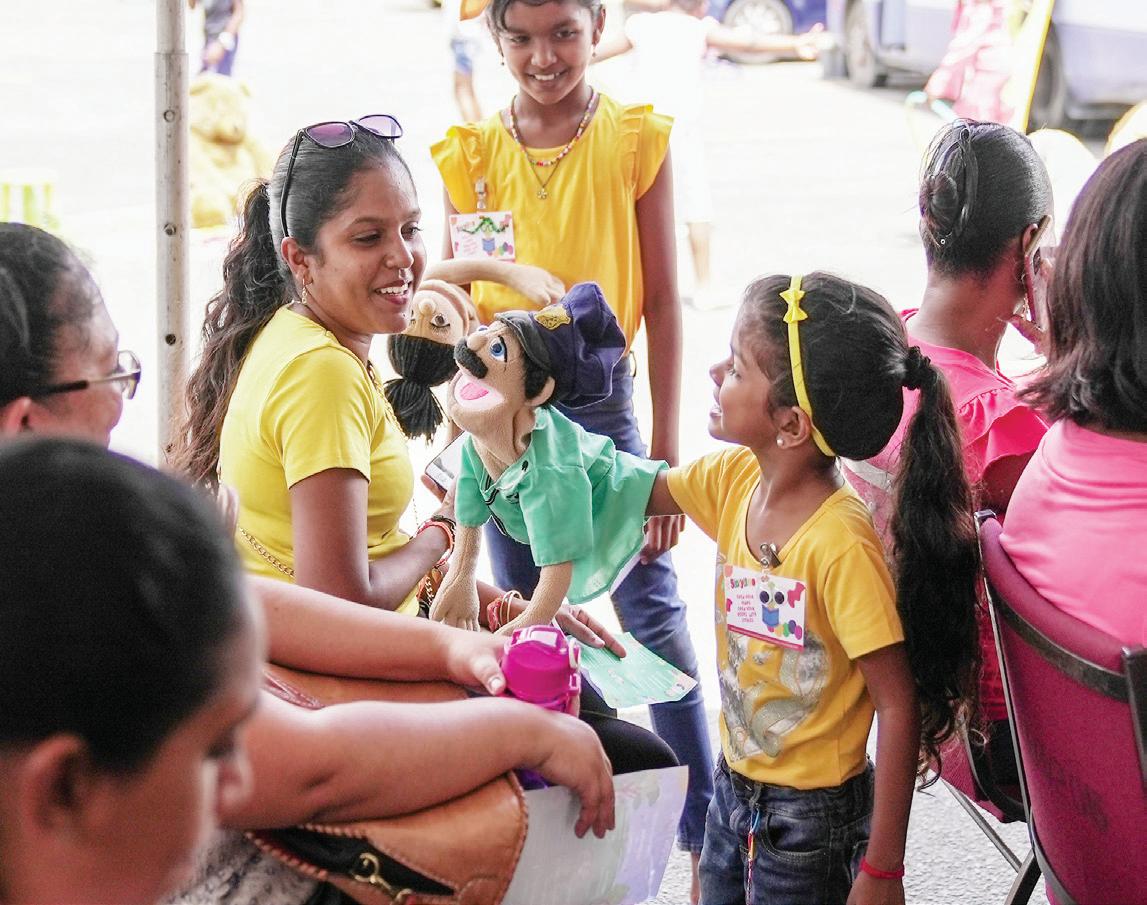




Hear a Story.” The children were attentive and interactive as Minister Manickchand read Dr Suess’ “Cat in the Hat.” As part of the activities, children played games and were exposed to
some aspects of Science, Technology, Engineering, Art and Mathematics (STEAM). They also toured the library bus and were encouraged to become members of the National Library.





CLINICAL laboratorians, said to be the “unseen heroes” in a hospital setting - aiding doctors and nurses in the background with diagnosis – usually get a chance to raise awareness about the work they do during Medical Laboratory
Observed annually to highlight and show appreciation for laboratory professionals, the week this year began on April 23 and concluded yesterday under the theme, “The Future is Lab.” The theme sought to create awareness and excitement about working in a laboratory
setting.
Every day, from routine blood tests to groundbreaking genetic and molecular tests, laboratory technologists across the world do the foundational work to support screening, diagnosis, monitoring, and treatment of disease.
“Everyone knows about
doctors and nurses and the roles they play, but lab technicians are usually the unseen heroes. We do the testing, make the connection with what the doctor suspects a patient might have, and we are able to confirm that diagnosis through our testing. We help the doctors to diagnose and correctly treat the patient,” Sharon Watson Rafiek, who recently earned her Bachelor of Science in Clinical Laboratory Science from the University of Guyana (UG), explained.
Speaking with the Sunday Chronicle, Rafiek, who has been in the field for 16 years, working in a variety of medical laboratory divisions in both public and private organisations, called attention to the importance of ‘Lab Week.’ “It brings awareness of who we are and what we do,” she said.
At several hospitals and testing sites, many youngsters who have just graduated and entered the system are the ones who usually do testing. Rafiek, who is the Regional Laboratory Manager with responsibility for all the labs in Region Three (Essequibo Islands/West Demerara), has put to rest concerns that those young professionals may not be truly up to speed with what is required for an accurate diagnosis.

According to her, the Medical Laboratory Professionals Programme that is done through the Ministry of Health features seasoned health professionals who carry out the training.

“There are persons who are filtering down their knowledge to the youngsters who are now coming into the field. These youths have to pass within a particular bracket before they can be allowed to work,” she pointed out.
In addition to the training,
they would be attached to several different institutions that are testing while they are still in the ‘classroom,’ so that they are able to benefit from on-the-bench experience while they are still being taught about the various aspects of the profession.
Furthermore, Rafiek called attention to the fact that the UG programme has been upgraded and brought up to the standards of overseas universities.
“So, the public should be confident in these ones testing their samples because from both sides, the Ministry and UG, they ensure that these persons don’t only have book knowledge but on-thebench experience.”
According to the standards that are used through the local body, the Guyana National Bureau of Standards, it is required that results be reported and that whatever results are going out, it should bear at least two signatures - the person testing and the person overseeing the lab.

Meanwhile, Ceenarine Rampersaud is one of the few males in the profession who has been working at the West
Demerara Regional Hospital (WDRH) as a Medical Laboratory Technician for the past 10 years. He hails from the Island of Leguan and his passion is to return to his beautiful island to serve the people there.
Tushanaw Patrick, another lab technician, began her career as a work-study student. She's been working as a lab professional for the past 13 years at the ‘West Dem’ hospital.
As for Melissa Thomas, she began as a volunteer at the Vreed-en-Hoop Health Centre in 2005 and opted to enroll in the Medical Laboratory Technician Programme in 2012. She is the supervisor of the Serology department which is responsible for detecting the presence of antibodies in the blood as a result of exposure to a foreign organism (bacteria, viruses).
Gomattie Deodat has been working as an allaround Medical Laboratory Technician at WDRH for the past eight years, while Alicia Debideen works at the Leonora Comprehensive Treatment and Diagnostic Centre as a Medical Laboratory Technician.
LAST week, Hess Corporation, which owns a 30 percent stake in the Stabroek Block, held its first quarterly earnings call of 2023. Chief Executive Officer John Hess highlighted Hess’ strategy of delivering high-return resource growth while maintaining their company’s position in the industry as a leader environmentally, socially, and in governance. Guyana, now ranked as one of the world’s preeminent new oil regions, played a significant role.
That news was confirmed a day later when ExxonMobil, operator of the Stabroek block announced its final investment decision (FID) on the Uaru project—a US $12.7 billion investment in Guyana that would add another 250,000 barrels per day (BPD) in production. FID is a critical final-stage commitment to moving forward with a project and only comes after extensive government and regulatory approvals are complete.
One of the main themes of the earnings call was the high production output already underway in Guyana. In Q1, the Liza Destiny and the Liza Unity floating production, storage and offloading (FPSO) vessels produced an average of 375,000 BPD. The start of the Prosperity FPSO later this year at the Payara project is expected to push that past half a million BPD with an additional 220,000 barrels per day. The addition of Uaru would also help
push Guyana to an estimated 1.2 million BPD by 2027. That potentially represents billions of US dollars in revenue, on top of the US $1.4 billion that is already in the Natural Resources Fund.

Already, Guyana has demonstrated that its oil and gas sector is moving at a rapid pace of development in the first three months of this year. As Guyana’s oil and gas sector continues to grow, with increased exploration and production at the Stabroek Block, local content will play an integral role.

Speaking earlier this month at a press conference, Vice President Dr. Bharrat Jagdeo reiterated that the pace at which Guyana is developing its resources is critical to ensuring sustainable returns on investments for local businesses, saying, “We’re encouraging a lot of Guyanese to invest in this sector. We are doing a lot of carving. The Guyanese, who we’re encouraging to invest, we don’t want their investments or their skills to be stranded.”
This pace of development is underscored by the numbers that came out of Hess’ earnings call, including the expectations for the Payara project. After that, the Yellowtail project will utilise the One Guyana FPSO with a production capacity of about 250,000 BPD and first production slated for 2025. ExxonMobil made the FID on that project last year.
Uaru would be the fifth development on
the Stabroek Block and was recently granted full government and regulatory approvals leading to the FID. MODEC—a highly respected Japanese oil and gas service company—will be constructing the FPSO for the project, which will be called the Errea Wittu. The Uaru US$12.7 billion (GY$2.638 trillion) project is expected to be the largest ever project to date offshore Guyana.
President of ExxonMobil Upstream Company Liam Mallon, on the advancement of the Uaru development in a recent press release, announced, “Our fifth, multi-billion-dollar investment in Guyana exemplifies ExxonMobil’s long-term commitment to the country’s sustained economic growth. Our Guyana investments and unrivalled development success continue to contribute to secure, reliable global energy supplies at this critical time.”
Looking ahead, Hess outlined a broad goal for future developments in Guyana. “On the Stabroek Block in Guyana, we currently have line of sight to six floating production, storage and all floating vessels, or FPSOs, in 2027 with a gross production capacity of more than 1.2 million barrels of oil per day.” This is a good thing for the country as increased production is inextricably linked to more oil revenues, and more oil revenues will continue to support the diversification of Guyana’s economy.
AFTER careful consideration, the Public Utilities Commission (PUC) has decided not to impose a penalty on the Guyana Power and Light Company (GPL), stating that, despite failing to meet its 2022 industry standards, the utility company continues to implement innovative measures to counteract challenges.
This decision was taken after the Commission conducted a review of GPL’s operating standards and performance for 2022. Among several concerns, the report, which was released by the PUC on Saturday, under-
scored the high volume of customer interruptions in 2022, which was a total of 94 outages.
Apart from the fallen branches that make contact with power lines and cause electrical short circuits, GPL also told the PUC that the frequency of motor vehicles striking utility poles are an issue, and as such, the company

is exploring the possibility of the use of concrete poles in the future to curb this frequent occurrence.
The report stated: “The Commission implores the Company to make better efforts to reduce these levels as this will continue to negatively impact the economic development of the county.”
On the other hand, while GPL has maintained its inability to measure the voltage supplied to each consumer, the PUC has not only planned to engage the utility company on the matter but also advised them to devise quantitative measures on customer voltage levels as opposed to qualitative analyses such as responses to voltage complaints.
“The Commission believes that this critical parameter should be measured by GPL and whilst the Company may be unable to report on every customer’s voltage, it is of the view that feeders voltage profiles may be measured and if required, capacitors and voltage regulators can be installed to improve the voltage levels,” the report stated.
In the area of system


losses, while the company did meet the standard, the report maintains that there is still a high percentage of technical and non-technical losses.
The Commission stated that: “GPL needs to make a greater effort to reduce these losses as it will continue to hamper efforts to reduce the price of electricity to consumers.”
Moreover, the Commission noted that despite the relatively small population of maximum demand consumers, GPL continues to report its failure as it relates to the attainment of the meter reading standards.
The review read: “Defective handheld devices which are used to remotely read meters have been the constant reason for failure of achieving this
standard.”
However, the PUC did commend GPL for its efforts in procuring new handheld devices which, according to its review, “will no doubt bode well in the future attainment of this standard.”
Owing to the prospect of improvements, the PUC stated that it is hopeful that the utility company will be able to meet the target, this year.
In concluding its report, it was said: “the Commission however wishes to emphasise in this decision that it will continue to vigorously monitor the electricity sector so that GPL would be properly positioned to reach its contractual obligations and legal mandate to the consumers of Guyana.”
A GROUP of heirs and successors of British slaveowners calling on King Charles and the Royal Family to follow their example and “Apologise for Slavery” and begin a process of “Reparative Justice” for the Caribbean, is also interested in doing the same in Guyana.
Among the group calling itself ‘Heirs of Slavery’ is Charles Gladstone, a second cousin of King Charles and a direct descendant of Prime Minister William Gladstone.
Today’s Gladstone, whose ancestors also owned plantations in then British Guiana, said, in a written statement to the UK press, that he joined the group “in an attempt to begin to address the appalling ills visited on so many people by my ancestor John Gladstone.”
John Gladstone, father of the prime minister William Gladstone (who served for 12 years over four non-consecutive terms from 1868 to 1894), was paid £106,000 compensation (worth at least £17m today) after the official Abolition of Slavery in the UK in 1834.
The Gladstone slave-owning family also paved the way for the start of Indentureship in the Caribbean, first through Guyana and Trinidad & Tobago, securing Indian labour to replace the unchained slaves after the successive ‘Abolition’, ‘Emancipation’ and ‘Apprenticeship’ schemes ended in the mid-1800s.
The ‘Heirs’ are among a few but growing number of representatives of UK families with slavery links committing to help push the Caribbean governments’ reparations agenda in the UK and the Caribbean.
They launched ‘Heirs’ on April 24, to lobby the UK government to acknowledge and atone for its role in the kidnap and transfer of 3.1 million enslaved Africans to its West Indian colonies during the Trans-Atlantic slave trade.
They also want to convince the thousands of other UK (English, Irish, Scottish and Welsh) families also paid slavery reparations to join or follow their example and make family amends, even though 199 years later.
The ‘Heirs’ are also calling King Charles to engage
with the 14 Caribbean Community (CARICOM) Governments that officially called almost a decade ago (November 2013) for the UK and European nations that built empires off slavery to start a dialogue about Reparations.
Approaching a decade later, neither the UK nor the European Union (EU) has afforded the 14 CARICOM leaders even an acknowledgement, far-less a long-overdue collective response.
However, the CARICOM Reparations Commission (CRC) hasn’t been just sitting on its hands -- or laurels.

Charged to pursue CARICOM’s 10-Point Plan for Reparatory Justice, the CRC held its 30th Quarterly meeting on April 25, where members also discussed the ‘Heirs’ and their role in supporting CARICOM’s reparations quest.
But the ‘Heirs’ have already started establishing Caribbean reparations connections.
On February 27, with the co-operation of the CRC and its Chair, Vice Chancellor of the University of the West Indies (UWI), Sir Hilary Beckles, the Trevelyan Family opened a private family fund in Grenada with 100,000 Pounds Sterling (equivalent of US $100,000).
The Trevelyan fund will be used for mainly educational purposes and will continue to be contributed to by family members, over 100 of whom signed a formal apology and related pledge, delivered to (and accepted by) Grenada’s Prime Minister and members of the island’s Cabinet, who attended the February ceremony.
The seed money for the Trevelyan Family Fund is actually ex-BBC presenter Laura Trevelyan’s entire retirement pension upon leaving the corporation (after 30 years’ service), to promote Reparations for the Caribbean.
But a lot’s also been happening on the flipside of the penny, including UK parliamentarians calling for peers with links to slavery to examine their consciences -- and also engage with CARICOM.
Interestingly, two UK MPs were suspended by their parliamentary parties: a Conservative who said slavery
should still be alive and a Laborite for writing a letter to the press with her views on racism in the UK.
Same across The Atlantic in the USA, where last week’s 5th State of the Black World Summit (SOBTW) in Maryland took place against the background of popular TV host ‘Dr Phil’ saying giving hundreds-of-thousands of dollars by way of reparations for poor African Americans would be “an absolute disaster”; and an Ohio Republican candidate saying that if elected, he’ll call for “Reparations for White Americans who died to free Black American slaves…”
But all this isn’t happening just because King Charles or President Biden were awoken by bad dreams.
Instead, it’s because, on both sides of the Atlantic, they’ve smelt the tea and the coffee, with UK public opinion hardening against racism, while the reparations movement continues making waves across America ahead of another presidential election.
Recent polls show more non-white UK citizens (including of Guyanese and Caribbean descent) feel the Royal Family has “a problem with race…”
However, many also feel that Charles, because of his persona, “can make the connection...”
The new king has to manage the Royal Family’s necessary adjustment to the accelerating rise in anti-slavery and pro-reparations sentiments abroad – and at home, accentuated earlier by revelation there was concern in the royal household about how Prince Harry’s first child (with his African-American wife Meghan) would look.
No one needs a research study to prove Buckingham Palace was involved in starting and continues benefitting greatly from riches inherited from Transatlantic Slavery, but King Charles has confirmed commissioning one -- and says he’s also likely to consider Reparations.
Now he’s being loudly called-upon by blue-blooded heirs and successors of British slaveowners to apologise, atone and amend.
As with every family
that benefitted from slavery, the Royal Household is also divided on Apologies and Reparations for Slavery; and successive UK governments have refused to even entertain discussions on Reparations,
for fear of legal consequences of admitting guilt of having committed -- and profited eternally from -- what the United Nations has designated the “Worst Crime Against Humanity”.
But while Buckingham Palace wonders and ponders, the ‘Heirs of Slavery’ have started apologising and atoning in the Caribbean, starting in Grenada. Will Guyana be next?


Minister of Public Works, Juan Edghill, providing an update on Saturday, said that the announcement date for the installation will be made after all systems are in place.

“We have to get into position [and] get everything in place. We have to get an agreement with all of the stakeholders because once it is going to be installed, it is going to cause interruption,” Minister Edghill told the Sunday Chronicle.
The replacement of span nine is a massive undertaking that cannot be done while traffic is flowing. The removal of the existing span will leave a significant gap on the bridge.

Therefore, it is imperative that everything is done correctly and that the replacement process is executed flawlessly. Once replaced, citizens will be able to see an enhanced retraction operation with a wider capacity to move vessels through the bridge.
The ministry will be utilising the newly commissioned power barge to transport citizens from the east to the west side during the replacement operation.
In October 2022, at approximately 02:00hrs the MV Tradewind Passion, a ship consigned by GuyOil to transport fuel, which also carries a Panamanian flag, crashed into the bridge.

The ship, which was supposed to drive in a southern direction to pass through the opening of the bridge, instead drove in a south-easterly direction and hit Spans Nine
and 10 with its front and rear.
This resulted in the two spans of the bridge shifting some 45 degrees out of alignment. The ship was the fifth vessel to pass through the bridge for the morning. Following the collision, the vessel has since been impounded and the pilot and crew were confined to the vessel. The collision sent several DHB workers, who were on the bridge at the time, literally running for their lives.
Following assiduous work by the DHB staff and support from the private sector, the bridge was then reopened to vehicles weighing up to 12 tonnes a few days after and it was later announced that vehicles weighting up to 18 tonnes would be able to cross the bridge under special conditions.
AS Guyana hurtles towards massive expansion and development, President Dr. Irfaan Ali has ensured that Region Three (Essequibo Islands-West Demerara) will also benefit tremendously from the advancements.


In the circumstances, he said that the $11.8 billion Schoonord-to-Crane four-lane highway will be completed before the end of the year.
President Ali made the disclosure on Saturday during the opening of the Sheriff Hospital, the first private hospital in the region. The four-lane road project, which had an expected completion date of June 2024, will feature an emergency lane, medians, roundabouts, reinforced concrete culverts, and pre-stressed bridges to alleviate traffic congestion along the West Bank and West Coast of Demerara.
A new roundabout will also connect the West Coast Demerara Highway to the new Schoonord-toCrane Highway. Further, the project is expected to open avenues for improvement in economic activities.

The Head of State said, “We will deliver, long before the end of this year,
the new four-lane highway from Schoonord to Crane in record-breaking time. While all of that is going on, more than $25 billion is being expended on the housing sector. Housing, health and education are integrated in such a way that there must be a seamless development, if we are to have sustainable development in these three areas.”
He added that from the government and the private sector, more than US$1 billion has been invested in Region Three. Highlighting the gamut of investments being made in the region, the head of state noted that some $200 billion in ongoing works are being conducted in the region, as the government continues to mould the region, and by extension, the country, to become a hub for investment.
“This government is delivering better education, better housing, better infrastructure, better health, a better country; not for People’s Progressive Party Civic supporters, not for any particular group, but for all the people of Guyana,” he reassured those gathered at the event. (DPI)

THE Guyana Police Force (GPF) is in the process of overhauling and modernising its services in an effort to improve service delivery and in keeping with global standards of law enforcement.
Commissioner of Police (ag), Clifton Hicken,
gineering at the Art Williams and Harry Wendt Aeronautical Engineering School, at Ogle, East Coast Demerara.
Hicken explained that police stations are undergoing continuous rehabilitation and reconstruction across the country.
during the recently concluded Police Officers’ Conference, revealed that the force aims to establish an aviation unit.
This, he said, will “bring us on par with our counterparts within the region and further afield.” Deputy Commissioner of Police for ‘Administration’, Calvin Brutus had revealed that two police officers completed a pilot training programme in Miami, United States and other ranks are pursuing degrees in aeronautical en-

“The continuous reconstruction and rehabilitation that are taking place at the police stations will see them equipped with all the modern amenities to m eet international best practices, with safe ID parade rooms, ramps for persons living with disabilities, [and] child friendly,” Hicken relayed.
In addition, critical police departments are being decentralised in an effort to make all the regions self-sufficient. (DPI)
CONSTRUCTION has commenced on the modern $1.7 billion Karasabai Secondary School in Region Nine, as part of the government’s aim to ensure equitable access to education is provided.
The construction of the school is scheduled to be completed within two years and will benefit 500 students and 250 students in the dormitories. Students will no longer have to travel through difficult terrain every day to receive education.


The government is putting a lot of effort into
closing the education gap between the coast and the hinterland. This initiative will significantly improve the quality of life for students in the region by expanding their educational opportunities.
The contemporary school complex will be fitted with ten buildings which include TVET centres, a combined Home Economics and cafeteria area, teachers’ quarters, an outdoor seating plaza, main teaching block and related lecturing facilities, and modern science laboratories for Physics,

Chemistry, and Biology.
Construction of the facility is being done by Avinash Contracting. The contract-signing ceremony which was held in February was attended by Minister of Education, Priya Manickchand; Minister of Local Government and Regional Development, Nigel Dharamlall; Permanent Secretary of the ministry, Alfred King, and Assistant Chief Education Officer for Amerindian and Hinterland Education Development, Marti DeSouza. (DPI)
From the issuing of ID cards and permits, to the dispensing of subsidies and the collection of taxes, Latin American and Caribbean governments manage between five and 20 transactional services per person each year. These services are often slow and cumbersome, requiring citizens to make multiple trips to government of -
fices and using up large amounts of their time. As a result, government services have become a focal point of corruption, as citizens try to short circuit the painstaking process with bribes. Indeed, according to Transparency International, a non-government organisation dedicated to good government, a third of Latin Americans paid
a bribe to access a public service in 2017.
Digitalisation can help ease these burdens, reduce costs, and promote cleaner government. Digital public services are on average 74 per cent faster than their in-person equivalents, reducing incentives for bribery, and 95 per cent cheaper for public institutions to deliver.

These and other benefits can be seen clearly in a recent report in which we analyse three cases of how digitalisation can improve service delivery in Peru, Chile, El Salvador and Jamaica while generating cost savings for their societies. Our specific numerical fig-
ures come from the case of Peru.
Consider the application of biometric technology, which allows governments to use physical characteristics such as fingerprints or iris scans to identify citizens. This digital form of authentication can reduce waiting times at government offices, reduce the paperwork involved in a transaction, and increase the accuracy of transactions like transfer payments. In its most sophisticated form, it can even eliminate the need to go to a government office.
A study in India on the use of biometric systems to identify recipients of subsidies found that the use of
whose ID cards were set to expire between January and August 2020. The messages reminded the citizens of the cards’ expiration dates, and increased the likelihood of ID renewal from 59 per cent to 72 per cent and timely renewal from 25 per cent to 39 per cent. Every dollar invested to set up this system generated a potential return of $2.1.
The same research also found that including a link in the text messages to begin the ID renewal process online also generated a significant increase in the probability of renewal. But this increase was lower than that for people who just received a text message. The problem was

smartcards to deliver two large social programs eventually enabled beneficiaries to collect their payments 20 per cent faster. It also reduced corruption by generating more accountability for those that distribute the subsidies while eliminating payments to ineligible people or to fictitious beneficiaries. A cost-benefit analysis found that each $1 dollar invested generated a return to society of $3.9, and would lead to a net present value of $7 million in Peru if there was a one-year, nationwide rollout for all those eligible. There is a caveat, however. Implementation of such systems is complex, and costs may vary depending on the context and coordination across the institutions implementing them.
The first step in any citizen-to-government transaction is making citizens aware that the government service exists and that they have an obligation to interact with it. WhatsApp messages, phone calls, and other tools can be an effective way to promote this awareness and increase citizen take-up. In a recent study, for example, three IDB researchers teamed up with the Electoral Tribunal in Panama to send text messages to a randomly selected group of citizens
that a poorly designed platform required users to upload a photo of themselves, while prohibiting “selfies.”. This, in turn, caused many users to abandon the process mid-way. Had that problem been overcome, the report suggests, the platform could have generated a return to society of $3.1 for every dollar invested.

Such difficulties may only be the teething problems involved in employing relatively new systems: in prioritising and implementing those technologies that work best and are most cost-effective. As more transactions come online with common and universally friendly interfaces, citizens may eventually turn to the digital option by default, rather than seeking non-essential in-person encounters when interacting with government services. Both governments and citizens would then reap ever greater returns on the overall investment. They would achieve solid fiscal and economic gains, as well as greater transparency, more accountability, and less corruption. (Inter-American Development Bank)
THE Juvenile Department of the National Library, on Saturday, launched ‘Storytime in the Park’ under the theme, “Come Hear a Story” where Minister of Education Priya Manickchand was a guest reader.

Chief Librarian Emily King stated that the initiative forms part of the library’s mandate to enhance literacy countrywide. She noted that it will promote reading, listening and comprehensive skills.
She further encouraged parents to help their children develop a love for reading as learning to read is one
of the most important childhood skills a child can have.
Assistant Chief Education Officer with responsibility for Literacy, Samantha Williams deemed the event a timely one and congratulated the National Library for the initiative.
She stated that literacy is everybody’s business and to this end, in May, the National Department of Literacy will be launching the Read Guyana Challenge.
Williams explained that every Monday, children will read a story from a selection of sto-
ries and write a book report. At the end of the month, participating children will receive a Super Reader certificate.
She also disclosed that work is being done to resuscitate school clubs and libraries to promote reading.
As part of the activities, children played games such as hopscotch and ludo, and were exposed to some aspects of Science, Technology, Engineering, Art and Mathematics (STEAM). They also toured the library bus and were encouraged to become members of the National Library.
AN online webinar called ‘Let’s talk mental health’, hosted by Mental Health Consultant and owner of Azadi Psychological Care, Zayn Alli, will be launched with its first session on May 1, 2023, at 18:00 hrs.

According to Alli, it is virtual and open to all members of the public, to discuss mental health and its underlying issues in a safe, non-judgmental space.
The webinar will be held either once or twice per week, depending on feedback from participants, and will centre around different topics each session, such as anxiety, depression, mental health and religious beliefs, and more.
He said this webinar aims to create a society where persons embrace mental health in Guyana.
“A lot of people want to reach out but they don't know how they can reach out or they don't know who to reach out to…the main objective is to bring more awareness for mental health,” he said.
Alli said that it is a free discussion webinar for persons to talk about their mental health issues and they can attend as guests if they want to keep their identities private.
He said that professionals, as well as himself, will be available to give advice and hold discussions during the webinar.
The mental health consultant explained that he originally wanted to start a podcast about mental health but realised that there was no room for discussion there since it would just be him talking.
“What if people want to be able to have discussions about it? Let me not do a podcast. I'll do a webinar where we can communicate and persons can communicate with professionals and we can be able to have question and answer segments and they can be able to contribute what they're going through; we can get the data from them, and we can try to help them as much as we can,” Alli said.
Noting that he came up with the idea of the webinar just over a month ago, he said right after, he began to create flyers and put systems in place to hold the sessions.
He will be utilising Google Meet which will be broadcast live to Instagram, Facebook, and TikTok.
Alli encouraged people to join the upcoming discussions because they are trying to create a more positive
environment where a person can openly say what they feel and ask for help, advice, and directions to key persons to provide them with help.
“If anybody in general has any questions or would like to know more about the education surrounding mental health, then this webinar is directly fit for those individuals,” he said.
Alli is in the process of completing his Bachelor of Science Degree in Psychology at the American University of Peace Studies and will move forward in 2024 to Arizona State University to complete his Master's.
He said that he is on the base of philanthropy, whereby he tries to donate as much as he can when he can.
“If we have donations, we can be able to donate it to persons in need. So, it is a bit all based on philanthropy work. I volunteer my time and effort into giving back to the community and I know I can't give back much but I can give the education that I'm learning and the education that I've learned so far so I can share it a bit around,” he related.
Alli started his company, Azadi Psychological Care, which offers consultation by linking a person with the psychologist or a psychiatrist
they may need.
The company is currently working on a website to provide people with more access to their services.
“They can be able to find the profile for each individual counsellor listed on
the website and they would be able to seek out mental health consultations. They can seek out psychotherapy and they can see the costs for sessions and it's all going to be on the website so you don't have to leave your
house to get mental health care,” he explained. Through the website, persons would also be able to book appointments online with the assurance of 100 percent confidentiality.



















(BBC) - FIFTEEN-yearold winger Lamine Yamal became Barcelona's youngest-ever player as they beat 10-man Real Betis to move 11 points clear at the top of La Liga.
The academy product, who turns 16 in July, was brought on in the 84th minute to replace Gavi.
At 15 years and 290 days, Yamal is the fifth-youngest player to appear in the competition.
Goals from Andreas Christensen, Robert Lewandowski, Raphinha and a Guido Rodríguez own goal secured the win.
Mallorca youngster Luka Romero is the youngest player to feature in La Liga when he came on against Real Madrid in 2020, aged 15 years and 219 days.
Yamal, who Barca boss Xavi Hernandez called "fearless", was included him in the squad for the first time against Atletico Madrid last Sunday.

Betis winger Joaquin, 41, who also featured at the Nou Camp on Saturday, had
already made 215 La Liga appearances when Yamal was born.
Barca took the lead when Christensen got on the end of Raphinha's inswinging cross to head home his first goal for the club from six
yards out.
Betis substitute Edgar Gonzalez, who had been brought on for the injured Luiz Felipe, was sent off in the 33rd minute after collecting two yellow cards in quick succession.
(Sunday April 30, 2023)
COMPLIMENTS OF CUMMINGS ELECTRICAL COMPANY LTD- 83 Garnett street, Campbellville, Georgetown (Tel: 225-6158)


Answers to yesterday’s quiz:
(1) Chris Gayle-733 runs (RCB)
(2) Chris Gayle-128* (RCB vs DD)
Today’s Quiz:

(1) Who took most wickets in IPL 2012?
(2) What were the best bowling figures in a single game in IPL 2012?
Answers in tomorrow’s issue
Lewandowski scored from a Jules Kounde cross three minutes later to increase the hosts' lead.
Raphinha added a third before half-time, following a lengthy video assistant referee check after the goal was
initially ruled out for offside. Then in the 82nd minute, Ansu Fati's cross was turned into his own net by Betis defender Rodríguez to seal the result.
10:55 hrs Senado Square
11:25 hrs Elle Dorado Rock
11:55 hrs La Dame
Blanche
12:25 hrs Timeless Piece
American Racing Tips
Aqueduct
Race 1 Risk Free Race 2 Heymackit’sjack Race 3 Pret A Toucher Race 4 Princess Sonya Race 5 Daunt

Canadian Racing Tips
Woodbine
Race 1 Green Cables
Race 2 Give Me My Money
Race 3 Money Matters
Race 4 Zoning Order
Race 5 Executive Chairman

(ESPNCRICINFO) -

When Fakhar Zaman has these kinds of days, there's very little any side can do about it; and what makes him so special is he has days like these with frightening regularity. A third successive ODI hundred - this one a monster century - by Pakistan's premier ODI opener blitzed New Zealand, as he cracked an unbeaten 180 off 144 balls.
It helped his side coast to their second-highest chase in the format, running down New Zealand's 336 with seven wickets and almost two overs to spare. A 135-run stand with Babar Azam, who scored 65, formed the backbone of the chase, while a devastating counter-attacking partnership with Mohammad Rizwan swept the game out of New Zealand's reach.
New Zealand had done plenty of things much better than they did in the first ODI, and yet, this game simply felt like a repeat. Daryl Mitchell scored a hundred, and New Zealand set themselves up for a huge total. And while they did get much further along than they managed in the first ODI by posting 336, a tight final three overs from Pakistan ensured the hosts grabbed some momentum at the death.
And Pakistan began the chase brightly once more, though Matt Henry did strike to remove Imam-ul-Haq in the final over of the powerplay; but the hosts kept coasting at above seven runs an over. Coming in at No. 3, Babar struggled through the first few overs of the innings, scoring just 16 runs in
his first 25 balls. Thus, the onus fell on Fakhar to ensure Pakistan remained on top of the asking rate, a burden he fulfilled with aplomb.
The real acceleration came in the 21st over when he launched Ish Sodhi for 17, speeding along to his tenth ODI hundred. He had brought up three figures in 83 balls, before launching Rachin Ravindra for a huge six over midwicket,
pressure taken off him as both experienced batters tore chunks out of the bowlers, particularly the inexperienced Ravindra. Fakhar brought up 150 and carried on, while Rizwan's own half-century arrived off the penultimate ball he faced as Pakistan eased to the win in the end.

Earlier, Mitchell's second successive hundred of the series had helped New Zealand to an im -
as by now Pakistan were purring. Babar had rediscovered his own touch too with a pair of boundaries against Henry Shipley, and was coasting towards another half-century.
New Zealand ran through the bowling changes but could simply find no way through, until an unforced error from Babar himself provided the breakthrough. He had tonked Sodhi for a six and a four in the 30th over, before a leading edge saw the ball fly up to Chad Bowes at short cover.
The visitors were then provided a glimmer when debutant Abdullah Shafique was prised out by Shipley, but Rizwan hit back with another effective counterattacking knock. It began with a regal cover drive off the first ball and continued with the same elegance. Fakhar had much of the
posing total of 336. A 183-run stand for the third wicket between him and his captain Tom Latham was the foundation of New Zealand's biggest ODI total in Pakistan, with Latham's 98 from 85 balls ensuring his partner had plenty of support at the other end.
Unlike the first ODI where New Zealand fell away sharply in the final ten overs thanks to a rock-solid bowling display by Pakistan, there would be less of a let-up at the death this time. New Zealand cranked through the gears in the final few overs to press home the advantage of the dominant position they had worked themselves into by plundering 98 runs in the final ten overs, with their innings featuring Mitchell's career-best 129 off 119 balls.
(ESPNCRICINFO) - In a game of high drama where both sides kept landing punches at each other with neither backing off, Sunrisers Hyderabad pipped Delhi Capitals to arrest a three-match losing streak on a low, slow pitch at the Arun Jaitley Stadium.

At one stage, Capitals were on track to gun down a 198-run target when Mitchell Marsh and Phil Salt put together 112 in just 11 overs after David Warner fell for a second-ball duck.
Then one wicket led to another, and before Delhi could realise, Sunrisers had clawed back courtesy of the guile of Mayank Markande, who picked up 2 for 20. Sunrisers now have three wins in eight games to Capitals' two in eight, which keeps them rooted to the bottom of the points table.
Abhishek's powerplay salvo
Back to open the innings after a game in the middle order, Abhishek Sharma be-
gan positively, lofting Ishant Sharma for two successive boundaries in the opening over. Mayank Agarwal's dismissal to a short ball gave Ishant some joy in his second over, but Abhishek wasn't in a mood to slow down. He took Ishant for four boundaries in the seamer's third over, hitting 43 in Sunrisers' 62 for 2 after the first six.
Capitals' comeback
The next four overs belonged to Capitals as they conceded just 21. Marsh left his mark on the game during this phase by taking pace off, the short boundaries notwithstanding, and allowing batters to force the pace on a surface where the ball was holding up. Two balls after he had Aiden Markram picking out deep midwicket, Harry Brook toe-ended a pull to the edge of the ring, Axar Patel the catcher on both occasions.
The Klaasen kick
After Abhishek raced to a 25-ball half-century, Heinrich Klaasen got into
the game by taking apart Mukesh Kumar as the 11th over went for 24. Abhishek began it with two back-toback fours and Klaasen finished it with a monstrous six down the ground off a leg-cutter. Axar, though, proved difficult to get away as he varied his pace and angles to finish with 1 for 29 from his four overs, the reward being the big wicket of Abhishek for a 36-ball 67. It could've been far more impressive if Klaasen hadn't belted him for two sixes to end his spell. A 53-run stand between Klaasen and Abdul Samad off 33 balls and some late runs from Akeal Hosein helped Sunrisers muscle 62 off the last five overs.
Warner falls but Marsh fires
Sunrisers couldn't have asked for a better start; Bhuvneshwar Kumar got Warner to chop on second ball of the chase. But Marsh and Salt raised the half-century of their partnership in just 29 balls by going after Ho-
sein's left-arm darts. Sunrisers tried to get overs out of spin seemingly in a bid to negate dew, but Hosein was far too short and the batters helped themselves to a nice spread against the short square boundaries.
After five overs, ESPNcricinfo's forecaster pegged Capitals' chances of victory at 19.43%, but after seven, this figure had jumped to 45.68%. The reason for that partly was Marsh's takeoff against Umran Malik.
Malik kept bowling short and into the body for Marsh to get inside the line and simply help it to beat long leg twice for sixes in a 22-run over. Salt opened and closed that over with two bludgeoning fours of his own against the short ball. That put Sunrisers under the pump.
Markande leads spinners into it
Markande used the slowness of the pitch to string together dots before dismissing Salt with a re-
turn catch that he just managed to hold on to. It was a big wicket considering Salt's maiden half-century had set the tone for the chase. Then seven balls later, Manish Pandey ran down the track only for Abhishek to shorten his length and beat him in the air and off the pitch.
It was now all on Marsh to see Capitals home, but that wasn't to be as Hosein hit back superbly after the early onslaught by dismissing him. After being walloped out of the ground on the previous delivery, he bravely tossed it up for Marsh to go again, except this one gripped and turned and Marsh sliced it to Markram. That, right there, was the game for Sunrisers. Axar muscled a few towards the end, but the middle-order slowdown after the SaltMarsh stand proved to be the difference.
(ESPNCRICINFO) - Rah-
manullah Gurbaz, filling in for the injured Jason Roy, scored 81 off 39 against his former franchise, Gujarat Titans, but Kolkata Knight Riders managed to score just 179, which Titans overhauled with 13 balls to spare despite a scare in the middle overs.

Gurbaz was sensational especially in his takedown of Rashid Khan, who went for 50 or more for only the second time in the IPL, but the only support he received was from Andre Russell, who scored 34 off 19 at the death. Josh Little tied them down in the middle overs, resulting in wickets, and Noor Ahmad registered the Afghan presence with 4-0-21-2, including the wicket of Gurbaz.
Shubman Gill, a former Knight Rider, set up the chase, and Vijay Shankar and David Miller finished it off in style after two quick wickets in the middle overs threatened to turn this into a thriller.
Shami with early strikes
The match started 45 minutes late because of a brief shower. That rumble of a thunderstorm at the time of
the wickets of N Jagadeesan and the promoted and returning Shardul Thakur. Gurbaz plays a different game
Pandya, and followed it up with a wristy pick-up six.
The most awesome perhaps was the attack on compatriot Rashid, making room, picking his variations, and hitting him down the ground, for 30 off 11. The middle overs were unable to slow him down.
Little slows KKR down
With Rashid taken for plenty, it was Josh Little who pulled things back for Titans. He just extracted extra bounce from hard lengths to frustrate the batters. His first two overs - seventh and ninth - went for just 10. At the start of his third, Venkatesh Iyer felt obliged to play a low-percentage shot, and was out lbw. In the same over, Nitish Rana found backward point with a cut.
Ahmad full toss having got only 54 off 53 from the other end, including extras.
Only a late burst from Russell kept Knight Riders in the game, but he himself admitted in a sideline interview that they were 20 short.
Gill launches the chase
The way the ball sounded like gun shots off Gill's bat, it looked like Knight Riders were way more than 20 short. He raced away to 35 off 20 in the powerplay without even trying to hit a six. Like Gurbaz, he dominated by scoring 44 of the first 70 runs.
KKR spinners refuse to go down
wicket in six matches.
A grandstand finish looked likely as Vijay and Miller absorbed some dots to make it 69 required off the last six.
Don't take it deep
the toss made Titans change their mind and chose to bowl. The pitch was spiced up, and
Mohammed Shami found seam movement. He bowled through the powerplay to get
Even as the others struggled to hit boundaries, Gurbaz middled almost everything and kept hitting to where the fielders weren't. He began with a pick-up pull off Hardik
This is when the arrival of Rinku Singh, hero of the last match against Titans but under a run a ball against spin in the IPL, slowed Knight Riders further down. Eventually, Gurbaz fell to a Noor
Not for the first time, the Knight Riders spinners dragged them back into the contest with some tight overs. Just as Hardik began to open up, he got a peach from Harshit Rana, filling in for the injured Umesh Yadav. Having taken 10 balls to go from 40 to 49, Gill tried to hit Sunil Narine for a six, but ended up giving him his first
The virtues of taking chases deep get spoken about often because the ones finished early don't have the drama attached. Miller and Vijay could have absorbed three more overs of spin and waited for some pace in the end, but they decided otherwise. Miller first took on Suyash Sharma and hit two sixes, which hurried the return of pace. Now Vijay got into the act, hitting a six off Russell before dismantling his Tamil Nadu team-mate Varun Chakravarthy with three sixes in the 17th over. Before you realised, he was bringing up his fifty in just 24 balls, and Titans were back on top of the table with six wins out of eight.
CMC – A destructive spell from Barbados Pride and West Indies pacer Kemar Roach, including his 500th first-class wicket, blew Warwickshire away and set up defending champions, Surrey, for a nine-wicket win in the English County Championship on Saturday.

The 34-year-old
going.
“I’m a huge Kemar Roach fan, and I enjoy seeing him bowl,” Sir Curtly said. “I want to congratulate him on his milestone of 500 first-class wicket. That’s a huge achievement for a fast bowler.
“He’s one of the standout fast bowlers in world cricket and has always
Bradley Fredericks returned unopposed as President of the Upper Demerara Cricket Association (UDCA) following the election on Saturday afternoon at the Hymara Park in Mackenzie, Linden.
In the presence of Guyana Cricket Board president, Bissoondial Singh, Fredericks was unanimously given another term in office as the game is about to rebound in popularity in the mining
town.
Fredericks admitted, “The last term in office was not of the best, but at least we are making progress. We were able to at least run off one competition earlier this year. Last year there was much rain which affected the game in the region, but we had a team which participated in an Under 17 tournament three weeks ago. “
He then disclosed: “We were able to have three truck-
loads of dirt to build three wickets. Hopefully, with these three loads of stuff we can have three grounds ready to expand the game. In so doing, we will also have the Mackenzie Sports Club ground available for cricket. These grounds are West Watooka, Maria Elizabeth and Old England.”
Fredericks will once again have Andrew Forsythe as Vice President, Jacquey Bourne as Secretary with
Headley-Weekes Tri-Series game two
the Treasurer being Jeremy Johnson.
The Assistant Secretary is Nick Hartman, Assistant Treasurer Ryan Piggott and the Organising Secretary / Public Relations Officer is Kollis Smith. The three Committee Members are Karil Smith, Clayton Van Hersel and Pheona David.
The GCB’s Cricket Development Officer, Audwin Rutherford was also present at the AGM and Elections.
CMC – A RESOLUTE half-century from West Indies Test opener Tagenarine Chanderpaul was the main attraction when the second Headley-Weekes Tri-Series match between Team Weekes and West Indies Academy ended in a draw on Saturday in Antigua.
before Bishop scalped him and Chanderpaul to end with two for two from four overs.
The Academy gained 11 points from the match, keeping them on top of the standings with 29, and making them a shoo-in for the tournament trophy, having completed both of their matches.
Academy’s strong reply.
Wickham added only 17 to his bedtime score his Pride teammate McAllister bowled him for 121 almost six overs later. He counted only nine fours and one six from 270 balls in 317 minutes at the crease.
McAllister got Barbadian all-rounder Nyeem Young lbw for 14 in his next over, and Permaul cleaned up the tail, removing Bishop, McKenny Clarke, and Ashmeade Nedd cheaply in the space of 26 balls.
grabbed five for 34 from 13 overs and ended with match figures of eight for 67, and Warwicks were bowled out for 141 in their second innings on the third day of their Division 1 match at Edgbaston in Birmingham.
Blessed with ideal conditions to favour seam and swing, Roach reached his milestone when he got Warwicks captain, Will Rhodes, lbw for five in his fourth over for his third wicket before lunch that sent the hosts crashing to 22 for four at lunch.
There was no way back from there for Warwicks with Australian pacer Dan Worrall taking three for 55 from 15 overs to end the contest with seven for 93 –and with Roach account for all but five of the wickets Surrey took in the match.
Commenting on Roach’s achievement, former West Indies fast bowler Sir Curtly Ambrose hailed the durability of the Barbadian paceman and urged him to keep on
been a top-class performer. He should be proud of the accomplishment, and I urge him to stay fit and look to get more wickets under his belt.”
Ed Barnard propped up the Warwicks batting with a resolute 49 – his best score for the club – and Chris Rushworth, batting at 10, made 22.
Needing 11 to win, Surrey knocked off the runs in two overs for their second win in three matches to move to the top of the standings with 52 points.
After Surrey resumed on 211 for eight, their script went perfectly to plan, and they attacked judiciously to gain a 131run lead, in reply to the Warwicks first innings total of 150.
The Surrey tail wagged to add 70 in 10 overs and lift the total to 281 all out thanks to a top score of 88 from Jamie Smith and a merry 35 off 24 balls from Worrall.
In between showers that prompted a near twohour long delay, Chanderpaul gathered 53, and Team Weekes reached 107 for three in their second innings when the decision was taken to end the match on the final day of the four-day, first-class contest at the Coolidge Cricket Ground.
Chanderpaul propped up his side’s batting with a knock that included six fours from 117 balls in two hours, 40 minutes at the crease, after Team Weekes had dismissed the Academy earlier for 435 to concede a first innings lead of 34.
The son of former Guyana captain and West Indies left-handed batsman Shivnarine Chanderpaul shared 70 for the first wicket with Barbados Pride opener Zachary McCaskie either side of the long rain delay before three wickets – two to Pride left-arm spinner Joshua Bishop – brought the match to a dramatic close.
McCaskie made 31 before left-arm pace bowling Pride teammate Ramon Simmonds bowled him, and Leeward Hurricanes batsman Keacy Carty got 21
Team Weekes gets off the mark in the standings with nine, placing them in second, four ahead of Team Headley, against whom they play the final match in the tournament, starting on Wednesday at the same venue.
Earlier, the Academy lost their last six wickets for 35 in the span of 77 balls after they resumed from their overnight total of 378 for four.
Long-serving Guyana Harpy Eagles left-arm spinner Veerasammy Permaul was the chief wrecker and ended with three for 106 from 40.5 overs, and Pride pacer Jair McAllister snared two scalps to finish with four for 84 from 20 overs, making him the most successful Team Weekes bowler.
Academy opener Neil McKenzie added only 12 to his overnight score before he fell to Harpy Eagles pacer Niall Smith for 221 in the 10th over of the day.
The Jamaica Scorpions left-hander batted for 502 minutes, faced 386 balls, and struck 26 fours and one six, and he shared 259 with overnight partner Kevin Wickham for the fifth wicket that set the foundation for the
lb4, w1, nb1) 13
TOTAL (all out, 142.5 overs) 435
Fall of wickets: 1-27, 2-59, 3-140, 4-142, 5-401, 6-421, 7-426, 8-428, 9-428.
Bowling: Smith 25-6-61-1 (nb1); Drakes 28-6-86-0; McAllister 20-1-84-4 (w1); Sinclair 21-2-71-2; Permaul 40.5-6-106-3; Athanaze 8-1-16-0.
TEAM WEEKES 2nd Innings
T Chanderpaul c Anderson b Bishop 53
Z McCaskie b Simmonds 31
K Carty c Anderson b Bishop 21
*A Athanaze not out 1 B King not out 0
Extras (w1) 1
TOTAL (3 wkts, 41 overs) 107
Fall of wickets: 1-70, 2-106, 3-107.
Bowling: Young 13-3-33-0; Simmonds 7-4-14-1 (w1); Clarke 5-1-26-0; Wickham 6-1-25-0; Nedd 6-3-7-0; Bishop 4-2-2-2.
Result: Match drawn.
Points: WI Academy 11, Team Weekes 9. Umpires: N Duguid L Reifer.
REGAL Legends started their quest for honours in the inaugural Speaker’s Cup Legends Over-50 category with an emphatic 59-run victory over archrivals, Trophy Stall Lions, at the Everest Cricket Club ground, Camp Road, yesterday.
Led by a brilliant second-wicket partnership of 148 by Unisss Yusuf, who clobbered an undefeated 107 and 70 from Ramesh Deonarine, after losing the wicket of Mohendra Arjune (four) with just 11 on the board, Regal Legends reached a daunting 194 for two in their allotted
15 overs. Trophy Stall Lions were restricted 135 for eight, going down by 56 runs.
The partnership between the right-handed Yusuf, who slammed five fours and nine massive sixes and Deonarine, whose knock was decorated by four fours and five sixes, was reminiscent of their stand in the final of the Orlando Cup, played in March, when the two added 163 for the second wicket after Arjune was dismissed in the first over. Yusuf’s contribution then was 80 while Deonarine made 81.
Anil Beharry claimed both wickets, conceding 41 runs.
Lokeram Roopnarine was the mainstay for Trophy Stall Lions, hitting three four and six in a top score of 24 with Eric Thomas (three for 23), Deonarine (two for 18) and Yusuf (two for 37) sharing the wickets.
Regal Masters suffered mixed fortunes at the Queen’s College ground in the Masters Over-40 division, losing their first encounter to Ariel Masters while they made light work of Success Masters.
Paul Reid struck five sixes in 53 and got valuable support from Prashad Mahadeo (42 with five fours and two sixes) and Anand
Nazamudeen whose 35 contained one four and a six as Ariel Masters reached 144 for seven in 15 overs. There were two wickets each for John Percival, Manoj Arjune and Tyrone Sanasie.

Regal Masters could only muster 110 all out in 14.2 overs with opener Mahadeo being the standout with 42 (five fours and two sixes). Skipper Samuel Kingston (two for six), Arjune (two for 15) and Nazamudeen (two for 23) were the main destroyers.
Regal Masters then inflicted a crushing 131-run defeat on Success Masters who were shut out for a
mere 33 in 10.1 overs, replying to their opponents 164 for six in their 15 overs.
Balram Roopnarine (four for 10), Sanasie (two for six) and Ramraj Baljit (two for 26) were the bowlers responsible for the rout. Regal Masters were led to their
total by 38 each from captain Eyaaz Mohamed and opener Patrick Rooplall. The tournament continues today with the final set for tomorrow at the Everest Cricket Club ground.
Strikers Sports Club, which is famed for uplifting women by means of having them interacting through sports, launched its second annual “Salute to Mother’s” domino tournament on April 6th.

The tournament will conclude on May 11th at its clubhouse and was birthed four years ago by “Three the Hard Way.”
An appeal was made to corporate and individual sponsors to which Cevons Waste Management, under the stewardship of Mr. Morse Archer, readily assisted.
Having learnt of the format and the venture of an all-female event geared to giving back to mothers, he immediately threw his support by donating the coveted first prize with trophy and adopting a female team as a means of giving back to the community.
In his brief remarks, he complimented the organisers for the implementation of such a gesture in having females coming together to have fun in a conducive environment in a male- dominated sport and promised this will not be a one-off sponsorship when it comes to events like these. He congratulated all the teams taking part and was impressed with the camaraderie on display and urged his adopted team to be victorious.
Also visiting was the Vice President of the World Coun-
cil Domino Federation, Mrs. Veda Debellotte, who also was highly impressed with such a venture featuring females only and praised the organisers for taking time out for recognizing and honouring women folks, which is a scarcity in sports such as dominoes and charged the women folks to be supportive of each other.
All female teams were invited to take part in the tournament namely with the first six given preference based on first acknowledgements. The teams who first answered the call were Big Girls, captained by Yonette Christmas; 1966 LAW, captained by Valerie Fortune; In Time, captained by Loraine Rodney; C-Point, captained by June Watts; Cody Girls, captained by Carol Burrowes; and Cevons Big Boss Girls, captained by Charlyn Barnwell. The teams
will pay in a round robin fashion in which they will face off against each other four times in a points system basis. Last year’s winners were Cody girls.
Points awarded for each win will be 5 points while second placed will be awarded 3 points and third place will muster 1 point. Points will be added over the ten matches being played and the victors will be crowed champions via the team who has amassed the most points. In the event of joint points the winners will be determined by way of the amount of sixes, fives, etc.
Six rounds has been played to date with the points standing as follows: C-Point 21 points, Cevon Big Boss Girls 20 points, In Time 19 points, Big Girls 18 points, 1966 LAW 16 points and Cody Girls 14 points. With four rounds to go and with
the format of this competition, upsets are likely to happen.
Prizes for this event are 1st place: $150,000; 2nd place
$70,000, 3rd place $50,000 with trophies each. The winning team will receive one hamper each while one hamper will be awarded for the best player on the other competing teams. The MVP will receive a two burner gas range compliments of AP Gas Depot. There will be added on the spot surprises coming by way of other named sponsors such as ANSA McAL, Grace Kennedy Remittance Services, VSH UNITED GUYANA Inc., Massay Gas Products, Sterling Products Ltd. Kabie’s Jewellery, Dynasty Sports Club, Patterson Associates, Austin’s Imports, Triple M Investments, RJ Services, Pressy’s Gift Store, Luminous Electrical,
Raphael’s Trading, Big Boss Transportation Services, Ryan Rambalak, Andrew Bevaun, HJ 94.1 Boom FM, 4Eva Summa, Rio Café, Team Diamond and Apollo Place.
The next event which will be hosted in August is referred to as the flagship of all female tourneys, and is dubbed “Strikers Summer Special Part 6” in which all female teams will be vying for over $700,000 in prizes and giveaways. Last year’s tourney, which was fiercely contested by 11 all-female teams, was won by Yarrowkabra females, who took the coveted first prize of $200,000 plus a winner’s trophy and nine medals.
THE Guyana Rugby Football Union (GRFU) had a successful day of rugby yesterday at the National Park with the Trophy Stall Sevens tournament attracting much excitement and attractive play but at the end of the day, Police Falcons were on top.
The youthful Falcons side outlasted their more experienced sides in GDF A, GDF B and favourites Panthers to lift the cham-
pionship trophy, led by a Most Valuable Player (MVP) performance by Rickford 'Jimmy' Cummings.
In the final, Falcons made light work of GDF B 14-0 with Lionel Holder leading the way with one Try and two Conversions while Cummings again was pivotal with one Try to his name.
Theo Henry of Falcons, in an invited comment with Chronicle Sport posited that
he was very pleased with the work for his team. He continued that, "This lads are growing from strength to strength and I'm excited at what they can achieve because most of the players are young and they will only get better."
On the road to the final, Falcons were unbeaten with wins against GDF A, GDF B and Pathers. Meanwhile, GDF B defeated GDF A and drew with Panthers.



